Cha 茶月Tsuki
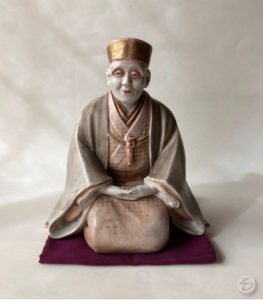
Cha茶月Tsuki is a continuous calendar of important events listed by month
The dates given in this calendar are for Japan, and may be different dates in other parts of the world, because of the location of the sun.
Chatsuki for December 2024
Jū-ni-gatsu, 十二月, Ten-two-month.
One of the old names for the lunar 12th month is Shi-wasu, 師走, Master-run. There may be a name connection with the Asian zodiac. The 12th month is the last month of the year, and the last Asian zodiac sign is the I, 亥, Wild Boar, and the actual animal is the inoshishi, 猪. An alternative writing for inoshishi is 亥の獅子. The Kanji for lion, shi, 獅, is composed of kemono, 犭, dog, and shi, 師, master. Pairs of animals that guard shrines and temples in Japan include Kara-ji-shi, 唐獅子, Tang-lions, Koma-inu, 狛犬, Korean-dogs, Inoshishi, etc.
Note: See Ro and Hai: Hearth and Ashes for further detail on Animal and Zodiac information.
Koyomi, 暦, Calendar, for the December 2024. Rei-wa, 令和, Order-harmony, 6th year.
Shi-wasu, 師走, Master-run; old name of the lunar 12th month. With all the preparations and holidays in December, it is such a busy time that even the teachers are running around.
1. Lunar Tsuitachi, first day of lunar 11th month.
5. Osame no Sui-ten-gū, 納の水天宮, End’s Water-heaven-palace.
7. Tai-setsu, 大雪, Great-snow, one of the 24 seasonal divisions of the solar year, and start of the Ne no Tsuki, 子の月, Rat ’s Month.
8. Koto-osame,事納め, Matters-end. Osame Yaku-shi, 納薬師, End Medicine-master. Jō-dō-e, 成道会, Attain-way-meet, the enlightenment of the Buddha.
Koto-hajime, 事始め, Matter-commence, start of New Year’s preparations. Kagami mochi, 鏡餅, mirror-mochi, is brought by students to teachers, in thanks for efforts of the past year.
9. Han-getsu, 半月, half-moon. Daikoku’s birthday. Dai-koku, 大黒, Great-black, is a Hindu deity that is one of the Shichi-fuku-jin, and the god of rice.
10. Dai-tō-sai, 大湯祭, Great-hot water-festival, held annual at the Ō-miya Hira-kawa Jin-ja, 大宮氷川神社, Great-palace Ice-river God-shrine, in Saitama City. It is one of the oldest shrines in Japan, founded about 2,400 years ago. Urasenke presents Ken-cha, 献茶, Offering-tea on occasion, with other Tea gatherings.
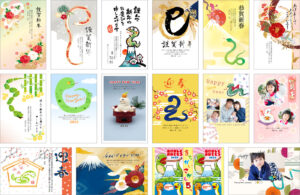
15. Man-getsu, 満月, Full-moon. Send New Year’s greetings, nen-ga-jō, 年賀状, year-joy-form. Sending New Years’ greeting cards first appeared in the Heian period, and continue to the present in the form of postcards.
18. Osame Kan-non, 納め観音, Settlement See-sound, last day of the year venerating the Buddhist goddess of mercy.
21. Ri-ttō, 立冬, Attain-winter; winter solstice, middle of the Ne no Tsuki, 子の月, Rat ’s Month. Yuzu-yu, 柚湯, citrus-hot water; yuzu, Citrus ichangensis x C. reticulata).
23. Han-getsu, 半月, half-moon.
25. Christmas.
27. Man-getsu, 満月, full-moon.
28. Monthly veneration of Sen no Rikyū. Osame no Fu-dō, 納めの不動, Settlement ’s No-move, last day of the year venerating the Buddhist deity who is the wrothful manifestation of Dai-nichi, 大日, Great-sun, who is the Buddhist universe made manifest.
31. New Year’s Eve. Jo-ya, 除夜, Exclude-night, New Year’s Eve. Ō-miso-ka, お晦日, Great-dark-day. Jo-ya gama, 除夜釜, Exclude-night kettle, last Tea of the year. Joy-ya no kane, 除夜の鐘, Exclude-night’s bell; temple bells are rung 108 times to dispel desires to which all humans are subject.
2025
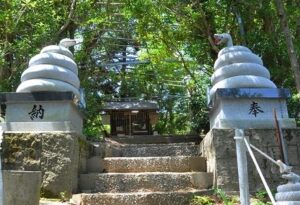
Stone guardian snakes at Ja-ō Jin-ja, 蛇王神社, Snake-king God-shrine, at Shi-man-tō-shi, 四万十市, Four-ten thousand-ten-city, Kō-chi, 高知, High-wisdom, Shi-koku, 四国, Four-states. The creature on the right has its mouth open, あ, the creature on the left has its mouth closed, ん. The Kanji carved on the bases read from left to right are hō-sō, 奉総, offer-all.
January 1, 2025. Year of the Snake, Dragon. Kinoe Tatsu, 甲辰, Wood’s older-brother Dragon.
29. Lunar New Year. Start of the Lunar Mi-doshi, 巳年, Snake-year. Kinoto-Mi, 乙巳, Wood’s Younger Brother-Snake. Gan-jitsu, 元日, Origin-day. National Holiday.

Chatsuki November 2024
Jū-ichi-gatsu, 十一月, Ten-one-month. Shimo-tsuki, 霜月, Frost-month, Tatsu-doshi, 辰年, Dragon-year.
1 Tsuitachi, 朔, first day of lunar 10th month.
3 Bun-ka no Hi, 文化の日, Literary-change’s Day, Culture Day. National Holiday. Annual festival, Mei-ji Jin-gū, 明治神宮, Bright-peace God-shrine, tomb of the Emperor, whose personal name was Mutsu-hito, 睦人, Harmonious-person, 1852-1912, Tōkyō.
4 Observe Bunka no Hi.
5 Ichi no Tori, 一の酉, One’s Chicken, first day of the Chicken after Rittō, Start winter. Day at temples and shrines for marketing elaborate talismans for the winter, and prosperity in business. The word tori refers to the zodiac Chicken, Rooster, Cock, Cockerel, etc. as distinguished from the common barnyard chicken, niwatori, 鶏.
7 Lunar ro–biraki, 炉開, hearth-open. Ri-ttō, 立冬, Start-winter; start of the lunar I no Tsuki, 亥の月, Boar’s Month: protected by A-mi-da, 阿弥陀, Praise-increase-steep, Buddha of Compassion. Exceptional confluence of the start of winter and the first day of the Boar, when the sunken hearth is opened.
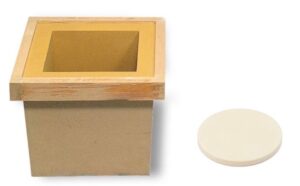
Ro-dan, 炉壇, hearth-foundation, hon-kabe, 本壁, true-wall; H. 13 x 16.5 sun kane-jaku: the opening 10 sun kane-jaku; by Ichi-son-sai, 一孫斎, One-descendant-abstain. The rodan is made of mortar in a wooden box, the interior with sand finish called Ju-raku nuri, 聚楽塗, Assemble-pleasure coat, named for Hideyoshi’s palace in Kyōto. The rodan is constructed in the same manner as traditional Japanese architecture, and the teahouse. The original Kanji for ro, 炉, is 爐, which is composed of ka, hi, 火, five, and ro, 盧, hut. The ro is a fire hut. Rikyū established the size of the ro opening at 14 sun kane-jaku.
9 Han-getsu, 半月, Half-moon.
10 Momi-ji Matsuri, 紅葉, Red-leaves Festival, Arashi-yama, 嵐山, Storm-Mountain, Kyōto.
11 Jō-u-sai Dai-matsuri, 上卯大祭, Upper-hare Great-festival, Matsu-o Tai-sha, 松尾大社, Pine-tail Great-shrine, in Kyōto, where the god of sake, 酒, is enshrined. Sake brewing begins on the first day of the Hare in November, celebrated at this ancient shrine. Sake is an essential part of a Chaji, 茶事, Tea-matter in the meal of kai-seki ryō-ri, 懐石料理, heart-stone material-process.
15 Shichi-go-san, 七五三, Seven-five-three; honoring children of ages 7, 5, and 3 years old at Shintō shrines.
16 Man-getsu, 満月, Full-moon.
17 Ni no Tori, 二の酉, Two ’s Chicken.
19 Sō-tan-ki, 宗旦忌, Sect-dawn-memorial. Sen Sōtan, 1578-1658: the date of his death was Man-ji, 万治, Ten thousand-peace, 19th day of the lunar 12th month.
20 Lunar Ebisu-ko, えびす講, Ebisu is the god of fisherman and merchants. Ebisu is the first-born child of the primal gods, and is the only Japanese god of the Shichi-fuku-jin, 七福神, Seven-fortune-gods.
22 Shō-setsu, 小雪, Small-snow; mid-point of lunar I no Tsuki, 亥の月, Boar’s Month. Tō-kan-ya, 十日夜, Ten-day-evening; lunar 10th day of 10th month, harvest festival. The gods of the rice field return to the mountains. People offer mochi dango, rice sheaves, eulalia grasses, and daikon to the moon.
23 Kin-rō Kan-sha-hi, 勤労感謝の日, Work-labor Emotion-thanks ’s day; Labor Thanksgiving Day. National Holiday. America’s Thanksgiving Day. Ni no Tori, 二の酉, Two’s Chicken, second day of the Tori in November.
28 Monthly Rikyū Memorial.
29 San no Tori, 三の酉, Three ’s Chicken. It is said that there are many fires in years with a third Tori day, and so there is a custom of taking precautions against fire. This is due to the legend that ‘when a rooster that does not crow at night crows, a fire will break out’, and the meaning is a call for caution as the weather gets colder and there will be more opportunities to use fire. Tori no ichi, 酉の市, Chicken’s market, originated as a market for farmer’s tools. There is wordplay on tori, 酉, chicken and tori, 取, take. Tori is the Asian zodiac sign symbolic of the West. In the chashitsu the sign of the Tori is the location of the teishu, and who may represent Fudō.
The Buddhist guardian of the sign of Tori is Fudō Myō-dō, 不動明王, No-move Bright-king. The halo, kō-hai, 光背, light-back, behind Fudō is made of 8 flaming chickens, symbolic of his omnipresence. Another Japanese bird sign is the Su-zaku, 朱雀, Vermilion-sparrow, the sign of the Southern quadrant of the sky, which is also a Fire sign.

CD Chatsuki Calendar October 2024
October, Jū-gatsu, 十月, Ten-month.
Kami-na-zuki, 神無月, God-no-month. The month in which all of the Shintō deities assemble at Izumo Taisha, 出雲大社, Out-cloud Great-shrine.
Kyū Ku-gatsu, 旧八月, Old Eighth-month.
1 Lunar 29th Day of the 8th Month.
2 I-no-ko mochi, 亥の子餅, Boar-’s-child mochi: the Japanese calendar lists the first day of the I, 亥, Wild-boar. Omotesenke Tea Offering at Kitano Tenmangu, Kyōto.
3 New Moon. Lunar Ku-gatsu, 九月, Nine-month.
4 Urasenke Ken-cha-shiki, 献茶式, Tea-offer-rite, Yasu-kuni Jin-ja, 靖国神社, Peaceful-country God-assembly, Tōkyō.
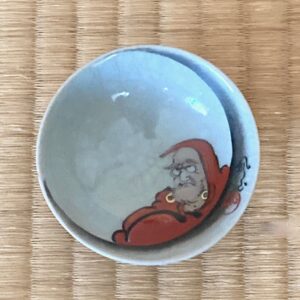
5 Daru-ma-ki, 達磨忌, Attain-polish-memorial, observances are held on the date of the death of Bodhidharma. Daruma founded Zen Buddhism in China, and meditated for nine years facing a wall. He lost the use of his legs, but continued to sit upright no matter the situation.
6 Urasenke Ken-cha-shiki, 献茶式, Tea-offer-rite, Iwa-shi-mizu Hachi-man-gū, 石清水八幡宮, Rock-pure-water Eight-banner-palace, Kyōto Pref.
8 Kan-ro, 寒露, Cold-dew; one of the 24 divisions of the solar year; start of the old month of the Inu, 戌, Dog.
Ken-cha, 献茶, Offer-tea, Yoshi-da Jin-ja, 吉田神社, Luck-field God-shrine, Kyōto.
11 Han-getsu, 半月, Half-moon. Lunar Chō-yō, 重陽, Multi-Yang. Chrysanthemum festivals are held across Japan.
12 Ba-shō-ki, 芭蕉忌, Banana-plant-memorial, for poet Matsu-o Ba-shō, 松尾芭蕉, Pine-tail Banana-plant.
13 Nichi-ren Sho-nin-ki, 日蓮聖人忌, Sun-lotus Holy-person-memorial. Urasenke is located on property of Nichiren temple, Hon-pō-ji, 本法寺, True-law-temple, in Kyōto.
14 Sports’ Day in Japan: National Holiday.
15 Jū-san-ya, 十三夜, Ten-three-night; waiting to see the 13th night of the 10th moon. It is a quiet occasion compared to waiting to see the full moon on the night of the 15th on the 9th moon.
17 Man-getsu, 満月, Full-moon.
18 Chrysanthemum Festival, Asa-kusa Kan-non, 浅草観音, Low-grass See-sound, Sen-sō-ji, 浅草寺, Low-grass-temple, Tōkyō.
20 Do-yō, 土用, Earth-matters; start of 18-day period where certain activities are either encouraged or discouraged.
22 Ji-dai Matsuri, 時代祭, Time-generation Festival; parade of people in historical Japanese apparel, with floats, Hei-an Jin-gu, 平安神宮, Level-peace God-palace. One of the three great festivals of Kyōto the other two being: Aoi Matsuri, 葵祭, Wild ginger Festival, May 15th, Gi-on Matsuri, 祇園祭, God-garden Festival, July 17th.
23 Sō-kō, 霜降, Frost-descend; one of the 24 divisions of the solar year; middle of the old month of the Inu, 戌, Dog.
24 Han-getsu, 半月, Half-moon.
28 Monthly memorial observance for Sen no Rikyū.
29 Jō-ō-ki, 紹鴎忌, Help-gull-memorial, for Take-no Jō-ō, 武野紹鴎, War-field Help-gull, Tea Master and teacher of Sen no Rikyū.
30 Ten-ryū-ji Ken-cha-shiki, 天龍寺献茶式, Heaven-dragon-temple Offer-tea-ceremony. Presented by Ura-sen-ke, 裏千家, Inner-thousand-family. Fu-ro Na-gori, 風炉名残, Wind-hearth name-remain, last Tea gathering of the furo season.

Chatsuki September 2024.
Ku-gatsu, 九月, Nine Month. Naga-tsuki, 長月, Long-month.
1 Lunar 7th month 29th day.
3 New Moon, Tsuitachi, 朔. Lunar Ha-ssaku, 八朔, Eight-first day. Start of lunar 8th month.
4 Kita-no Ten-man-gū, 北野天満宮, North-field Heaven-full-palace, annual festival. Kyōto.
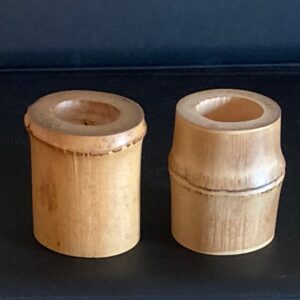
5 Sen Shō-an, 千少庵, Thousand Small-hut, Memorial: Shōan was adopted by Rikyū, and became the second generation head of the Urasenke. The moto-bushi take futa-oki, 元節竹蓋置, origin-node bamboo lid-place, is identified with Shōan, and the naka-bushi take futa-oki, 中節竹蓋置, mid-node bamboo lid-place, is identified with Sen Dō-an, 千道安, Thousand Way-peace, the eldest son of Rikyū. Sen Tan-tan-sai, 千淡々斎, Thousand Light-light-abstain, Memorial: XIV Iemoto of Urasenke.
7 Sen Ka-yo-ko, 千 嘉代子, Thousand Joy-generation-child, 1897-1980, Memorial. Wife of Tantansai and mother of Hōunsai.
Haku-ro, 白露, White-dew, one of the 24 seasonal divisions of the solar year, start of lunar Tori no Tsuki, 酉の月, Rooster-s Month.
9 Chō-yō no se-kku , 重陽の節句, Multi-nine’s season-passage: double nines. Kiku Matsuri, 菊祭, Chrysanthemum-festival.
11 Han-getsu, 半月, half-moon.
15 Rō-jin no Hi, 老人の日, Elder’s Day. Iwa-shi-mizu Hachi-man-gū, 石清水八幡宮, Rock-pure-water Eight-banner-palace, Kyōto, annual festival.
16 Kei-rō no Hi, 敬老の日, Respect-elder’s Day; National Holiday.
17 Jū-go-ya, 十五夜, Ten-five-night; autumn moon-viewing.
18 Man-getsu, 満月, full-moon. The Harvest Moon in the west.
19 Hi-gan Iri, 彼岸入り, Other-shore Enter; start of seven-day period culminating on September 22, the autumnal equinox. Shū-bun no Hi, 秋分の日, Autumn-division’s Day, and ending on September 25.
21 Kita-no Ten-man-gū, 北野天満宮, North-field Heaven-full-palace, monthly antique and flea market.
22 Shū-bun no Hi, 秋分の日, Autumn-division’s Day. National Holiday. One of the 24 seasonal divisions of the solar year and midpoint of lunar Tori no Tsuki, 酉の月, Rooster-s Month.
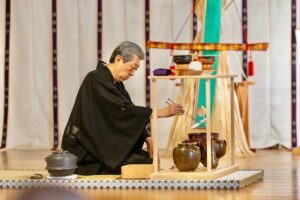
23 Shū-bun no Hi, National Holiday observed. Ken-cha-shiki, 献茶式, Offer-tea-rite, I-se Jin-gū, 伊勢神宮, That-strength God-palace, Ise City.
25 Hi-gan Ake, 彼岸明け, Other-shore End. Han-getsu, 半月, half-moon. Tō-ji, 東寺, East-temple, monthly antique and flea market.
28 Sen no Rikyū monthly memorial.

Chatsuki August 2024.
Hachi-gatsu, 八月, Eight-month. Ha-zuki, 葉月, Leaf-month.
1 Lunar 27th day, 6th month.
2 Lunar Ri-kyū-ki, 利休忌, Rich-quit-memorial.
4 New Moon. Lunar 7th Month.
5 Do-yō Ni no Ushi, 土用二の丑, Earth-works Second ’s Ox (day); broiled eels are eaten for energy. Memorial for En-nō-sai, 円能斎, Circle-art-abstain, XII Iemoto, Urasenke, Kyōto.
6 Hiro-shima, 広島, Wide-island, Bombing Memorial. Sen-dai, 仙台, Hermit-support, Tanabata, 七夕, Seven-night; purification for Obon on 18th.
7 Ri-sshu, 立秋, Start-autumn; 24 seasonal divisions of the solar year. Start of the lunar seventh month, Saru no Tsuki, 申の月, Monkey’s Month.
9 Naga-saki, 長崎, Long-cape, bombing memorial.
10 Kyū Tanabata, 旧七夕, Old Seventh-night, seventh night of the seventh lunar month, preparing for the O-bon, お盆, Hon.-tray, when spirits of the dead return to their homes. Han-getsu, 半月, half-moon. Stalks of bamboo decorated with tan-zaku, 短冊, short-volume, and ornaments dedicated to the Altair and Vega, summer cross. Bridge of magpies, kasasagi, 鵲.
11 Yama no Hi, 山の日, Mountain’s Day: National Holiday – the people are encouraged to enjoy the mountains.
12 Yama no Hi observing day off.
13 Han-getsu, 半月, Half-moon. Lunar Obon Mukae-bi, 迎え火, Welcome-fire. A fire is lit outside the home to welcome ancestral spirits.
18 Kyū Bon, 旧盆, Old Tray, when spirits of the dead return to their homes during the full lunar seventh month. O-bon, お盆, Hon.-tray. ‘Bon’ is a contraction of U-ra-bon, 盂蘭盆, Bowl-orchid-tray, which is derived from the Sanskrit word ‘ullambana’, meaning ‘hanging upside down’, and being out of reach of food.
19 Lunar Obon okuri-bi, 送り火, Farewell-fire. The spirits of the ancestors go back and forth to the world of Goku-raku Jō-do, 極楽浄土, Extreme-pleasure Pure-land.
20 Man-getsu, 満月, Full-moon.
22 Sho-sho, 処暑, Limit-heat; one of the 24 seasonal divisions of the solar year. Mid-point of the lunar seventh month, Saru no Tsuki, 申の月, Monkey’s Month.
24 Ji-zō Bon, 地蔵盆, Earth-keep Tray; devotion for children in Kyōto.
25 Monthly market at Kita-no Jin-ja, 北野神社, North-field God-shrine, Kyōto.
26 Han-getsu, 半月, Half-moon.
27 Lunar Ji-zō Bon, 地蔵盆, Earth-keep Tray; devotion for children in Kyōto.
28 Rikyū-ki, 利休忌, monthly memorial for Sen no Rikyū. Memorial for Tai-sō Sō-shitsu Ri-kkan-sai, 泰叟宗室 六閑斎, Peace- Sect-room Six-leisure-abstain, 1694-1726, VI Iemoto, Urasenke, Kyōto.
31 Ni-hyaku tō-ka, 二百十日, two-hundred ten-days, since the start of spring according to the lunar calendar.
For further detail on annual August events, see Chatsuki August 2022 below.

Chatsuki July, 2024
Shichi-gatsu, 七月, Seven-month. Old lunar calendar Fumi-zuki, 文月, Letter-month.
1 Lunar Go-gatsu, 五月, Five-month, 26th day. Han-ge-shō, 半夏生, Half-summer-live. Opening day for climbing Fu-ji-san, 富士山, Wealth-samurai-mountain.
5 Sei-chū En-nō Mu-gen-ki, 精中圓能無限忌, Spirit-mid Circle-skill No-limit-memorial, Ura-sen-ke, 裏千家, Inner-thousand-family, Kyōto. Memorials honoring Sei-chū, 精中 / Gen-gen-sai, 玄々斎, Mystery-mystery-abstain, 11th Oiemoto; En-nō, 圓能 / En-nō-sai, 円能斎, Circle-skill-abstain; 13th Oiemoto; Mu-gen, 無限 / Tan-tan-sai, 淡々斎, Light-light-abstain, XIV Oiemoto. Ei-sai Zen-shi-ki, 栄西禅師, Splendor-west Zen-master-memorial.
6 Tsuitachi, 朔, New moon. First day of the lunar 6th month, bears the old name Mi-na-zuki, 水無月, Water-no-month. Shō-sho, 小暑, Little-heat; one of the 24 seasonal divisions of the solar year, and start of the lunar sixth month, and the start of Mi-tsuki, 未月, Ram-month. The Kanji 未 means ‘not yet’.
7 Tanabata, 七夕, Seven-night. Star Festival. Ki-bune Jin-ja, 貴船神社, Precious-boat God-shrine, Kyōto; Urasenke Ken-cha, 献茶, Offering-tea. Lunar Tanabata is August 10, 2024.
9 Hō-zuki Ichi, 鬼灯市, Demon-lamp Market; at Asa-kusa Kan-non, 浅草観音, Shallow-grass See-sound, in Tōkyō, sale of plants for O-bon, お盆, Hon.-tray.
12 Kusa-ichi, 草市, grass-market, flowers and plants are available for the approaching Bon festival, July 15th.
13 Bon Mukaebi, 盆迎え火, Tray Welcome-fire; spirits return.
15 National Holiday. Bon, 盆, Tray, when spirits return to their ancestral homes. Offerings are presented on trays. Obon is a lunar event held in conjunction with the full seventh moon, with observances held from the 13th to the 16th. Lunar Bon is August 18, 2024, with the full moon.
16 Bon okuri-bi, 送り火, Tray farewell-fire, when spirits return to their eternal home. Ya-saka Jin-ja, 八坂神社, Eight-hills God-shrine, Kyōto; Ken-cha, 献茶, Offering-tea.
17 Gi-on Matsuri, 祇園祭, God-garden Festival, Ya-saka Jin-ja, 八坂神社, Eight-hills God-shrine, Kyōto. One of the three greatest festivals of Japan. There is a recent theory that the Japanese word Gion originated in the Hebrew word, Zion, from the time when one of the ‘lost tribes of Israel’ came to early Japan. Zion refers to a summit in Jerusalem, but the word is of uncertain origin. It was used in Semitic languages, and predates its use by the Israelites, for whom the word ‘Zion’ meant Jerusalem and the land of Israel.
19 Do-yō, 土用, Earth-works; start of one of an 18-day period when certain activities should be avoided or encouraged. There are Doyō at the end of each of the four seasons, creating a fifth season.
21 Man-getsu, 満月, full-moon. Tō-ji, 東寺, East-temple; monthly market and flea.
22 Tai-sho, 大暑, Great-heat, one of the 24 seasonal divisions of the solar year, and the middle of the Hitsuji-no-tsuki, 羊の月, Ram’s-month.
24 Do-yō no Ushi, 土用の牛, Earth-work ’s Ox. Japanese people eat broiled eels for endurance against summer heat. Ji-zō Bon, 地蔵盆, Earth-treasure Tray, Buddhist observances honoring Ji-zō Bo-satsu, 地蔵菩薩, Grass-buddha; he is the guardian of the Buddhist world until the arrival of the supreme Buddhist savior, Maitreya, Mi-roku Bo-satsu, 弥勒菩薩, Increase-rein Grass-buddha.
25 Kita-no Ten-man-gū, 北野天満宮, North-field Heaven-full-palace; monthly market and flea.
28 Ri-kyū-ki, 利休忌; monthly memorial for Sen no Rikyū.
31 Sen-nichi mairi, 千日詣, Thousand-day temple visit, Atago-yama, 愛宕山, Love-cave-mountain, northwest of Kyōto.
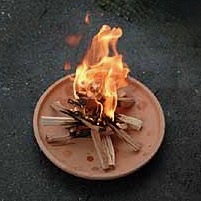
Fires for Bon are traditionally made of asa-gara, 麻幹, hemp-stalks, that are peeled and cut hemp stalks that are arranged in a cone on a low-fired terracotta hō-roku, 焙烙, roast-burn. In Chanoyu, the hōroku is used to carry utensils into the Tearoom for building a charcoal in February, in connection with the dai-ro, 大炉, great-hearth, which was conceived by Gen-gen-sai, 玄々斎, Mystery-mystery-abstain, XI Iemoto, Urasenke. The hōroku is a kind of a oven created with two dishes made into a covered container for foods cooked over a fire, for hōroku yaki, 焙烙焼.

Chatsuki June 2024
Roku-gatsu, 六日, Six-month. Mi-na-zuki, 水無月, Water-no-month, old name for lunar 6th month, which begins July 6, 2024.
June in Japan is the time of the rainy season and when the ajisai, 紫陽花, purple-Yō-flower, hydrangea flowers are at their most inspiring. The flowers are inappropriate for the Tearoom because the large blooms are gathered in great spherical clusters. A variety of hydrangea is used to make ama-cha, 甘茶, sweet-tea; Hydrangea macrophylla var. thunbergii (variety of bigleaf hydrangea). This ‘tea’ is ladled over small images of the infant Buddha, in the rites of Kan-butsu-e, 灌仏会, Libate-buddha-meet, observed on the 8th day of the 4thmonth of both solar and lunar calendars. This momentous event is also called Hana-matsuri, 花祭, Flower-festival.

There are exceptions of hydrangeas that may be displayed for a Tea gathering – gaku-ajisai, 額紫陽花, frame purple-Yō-flower, which in the west are called lacecap hydrangea. The flower heads are small with tiny flowers surrounded by a ring of ‘flower’-like bracts.
1 Lunar 4th Month, 25th day. Koromo-gae, 衣替え, clothing-change, light clothing replaces dark.
2 Mura-ta Shu-kō, 村田珠光, Town-field Jewel-light, memorial Tea.
5 Bō-shu, 芒種, Grain beard seed; one of the 24 divisions of the solar year. Start of lunar Uma no tsuki, 午の月, Horse’s month. Ken-nin-ji, 建仁寺 , Build-benevolence-temple, Ken-cha-shiki, 献茶式, Offering-tea-ceremony
6 New Moon. Lunar 5th Month.
7 Za-bō-sai, 坐忘斎, Sit-forget-abstain, Ie-moto no Tan-jō-bi, 家元の誕生, House-master’s Birth-life-day, XVI Iemoto, Urasenke, born June 7,1956, named Masa-yuki, 政之, Govern-go. The Ceremony of Succession for the new head of Konnichian, the 16th-generation successor of Sen no Rikyū, was held on December 22, 2002.
9 Ō-mi Jin-gū, 近江神宮, Near-port God-palace, Ken-cha-shiki, 献茶式, Offer-tea-ceremony, Ō-tsu, Great-bay.
10 Nyū-bai, 入梅, Enter-Japanese apricot; start of the rainy season (in Kyōto), which is also called tsu-yu, 梅雨, apricot-rain. Day to make ume-shu and ume-boshi. The rainy season in Japan varies from mid-June to mid-July. The Kanji, 梅雨, are read tsuyu only by tradition, but could be read ume-ame. A Kanji for tsuyu is 露, which is also read ro, as in the Teahouse garden ro-ji, 露地, dew-ground. In Buddhism, the Kanji, 露, means enlightenment. Lunar 5th month 5th day, Tan-go no Se-kku, 端午の節句, Start-horse’s Season-passage. Old calendar Boy’s Day. [see below]
14 Han-getsu, 半月, half-moon.
16 Chichi no hi, 父の日, Father’s Day. San-nō Hi-e Jin-ja, 山王日枝神社, Mountain-king Day-branch, Ken-cha-shiki, 献茶式, Offer-tea-ceremony, Tōkyō.
21 Ge-shi, 夏至, Summer-attain; mid-summer in Japan, starts summer in the west. One of the 24 solar calendar observances of the year, and the middle of the lunar Uma no tsuki, 午の月, Horse’s month.
22 Man-getsu, 満月, Full-moon.
28 Monthly Ri-kyū-ki, 利休忌, Rich-quit-mourning; memorial for Sen no Rikyū.
29 Han-getsu, 半月, half-moon.
30 Ō-harai, 大祓, Great-purification; major cleaning for the start of the second half of the year. Natsu-koshi, 夏越, Summer-cross over.
Tan-go no Se-kku, 端午の節句, Start-horse’s Divide-passage. Old calendar Boy’s Day. Five/five in Chinese is unlucky, because the number five, 五, which is read wǔ, is a homonym for wǔ, 嗚, weep, ah, alas, etc., and double wǔ wǔ is onomatopoeia for whimpering and crying. The Kanji 嗚 is composed of kuchi, 口, mouth, and karasu, 烏, crow, which is a bird with a fateful character and creation. The number 5 is generally considered an unlucky number, and offerings were intended to appease vengeful spirits. What may have been an unlucky occurrence in China, such as 5/5, in Japan, may have become an auspicious celebration, like Boys Day on 5/5.
Tan-go no Sekku, 端午節, Edge-horse’s Season, originated in China on the fifth day of the fifth month of the lunar calendar to commemorate Qu Yuan who was prime minister of the southern Chinese state of Chu during the Warring States Period, about 600 B.C. to 200 B.C., and features dragon boat races.
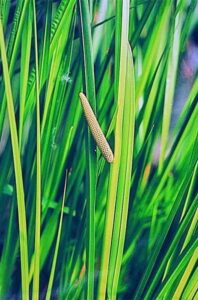
Part of the Tango events adopted by Japan is to put calamus and Artemisia (excluding the Chinese garlic) above the doors on the fifth day of the fifth month. These were believed to help ward off evil by their strong smell and their shape, and especially repels various insects. Aside from the blade-like leaves, calamus / sweet flags have a flower stalk that mimics male virility.

Chatsuki May 2024
Go-gatsu, 五月, Five-month, Satsu-ki, 皐月, Swamp-month.
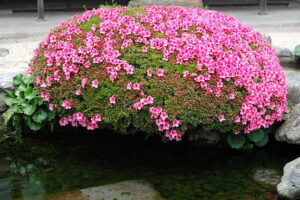
Satsuki no hana, 皐月の花, Swamp-month’s flower, is a kind of azalea that blooms at this time of the year, and are often pruned to form hillocks. Although the flowers are much admired in the garden, satsuki and every part of azalea plants can be poisonous or can cause some health distress, and therefore are unsuitable as chabana in the Tearoom.
The word sa-tsuki, 皐月, swamp-month, was abbreviated from sa-nae-zuki, 早苗月, early-seedling-month, related to rice cultivation.
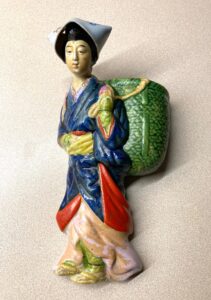
Kake-hana-ire, 掛花入, hang-flower-enter, ceramic wall pocket in the form of a cha-tsumi Ō-hara-me, 茶摘み 大原女, tea-pick Great-field-woman, Ban-ko-yaki, 萬古焼, Ten thousand-old-fired; H. 6 sun kujira-jaku. Not everything is appropriate in the Tearoom.
1 Lunar calendar 3rd Month 23rd Day. Hachi-jū-hachi-ya, 八十八夜, Eight-ten-eight-night, 88 days since Risshun, 立春, Start-spring, February 4th, and middle of 21 days of tea picking. In Japan, the beginning of May continues ‘Golden Week’, which began on Monday, April 29 Emperor Hirohito’s birthday, now called Showa no Hi, 昭和の日, Bright-peace’s Day, and ends on May 5, but as that is Sunday, ‘Golden Week’ ends on Monday May 6 .
3 National Holiday: Ken-pō-ki-nin-bi, 憲法記念日, Constitution-law-account-attention-day, Constitution Memorial Day.
4 National Holiday: Midori no Hi, 緑の日, Green-day, honoring Emperor Hiro-hito, 裕仁, Abundant-benevolence, which began in 1989.
5 National Holiday: Ko-domo no Hi, 子供の日, Children’s Day, Boy’s Day. Tan-go no Se-kku, 端午の節句, Edge-horse(zodiac sign)’s Season-phase. Ri-kka, 立夏, Start-summer, is one of the 24 seasonal divisions of the solar calendar year, within this calendar system there is reference to the lunation varies from other systems and as a result, within the 24 seasonal divisions it is the start of the ‘lunar’ Mi no Tsuki, 巳の月, Snake’s Month.
6 National Holiday: Tango observed. ‘Golden Week’ ends.
8 New Moon. 1st day of lunar Shi-gatsu, 四月, Fourth-month.
10 Sho-bu-ro, 初風炉, First-wind-hearth, first official Urasenke Tea presentation using the furo, the portable brazier. The deities who are have their En-nichi, 縁日, Edge-day, on the 10th day of every month are Nichi-gatsu-tō Myō-butsu, 日月燈明仏, Sun-moon-lamp Bright-buddha, a Buddha who preached the Lotus Sutra in a past life before Shakyamuni. Kon-pi-ra Gon-gen, 金毘羅権現, Gold-help-spread Power-exist, guardian of seafaring, who is identified with Su-sa-no-o Mikoto, 素戔嗚尊, Elemental-revered-cry Lord. Ama-terasu Ō-kami, 天照太神, Heaven-bright Grand-god, the Shintō Sun Goddess.
12 Haha no Hi, 母の日, Mother’s Day.
15 Han-getsu, 半月, Half-moon. Memorial of Mura-ta Shu-kō, 村田珠光, Town-field Jewel-light (1423-1502); restored Buddhism to Chanoyu.
17 Tō-shō-gū, 東照宮, East-bright-palace, Spring season great festival, Ni-kkō, 日光, Sun-shine. Urasenke Ken-cha-shiki, 献茶式, Offer-tea-rite, in memorial for Toku-gawa Ie-yasu, 徳川家康, Virtue-river House-peace (1543-1616). Chanoyu is presented at various locations at the shrine.
20 Shō-man, 小満, Little-fullness, one of the 24 seasonal divisions of the solar year, related to the development of growing rice, and the start of Mi no tsuki, 巳の月, Snake (zodiac)’s month.
21 Birthday of Shin-ran, 親鸞, Parent-mythical bird; founder of Shin-shū, 真宗, True-sect, of Pure Land Buddhism, observed at Higashi-hon-gan-ji, 東本願寺, East-Origin-vow-temple, Kyōto. There are many fantastical birds in the world, and the so-called mythic ran, 鸞, may have been inspired by the Great Argus Pheasant (argusianus argus). The courting male has a truly remarkable display, especially when it ‘dances’, which may also have inspired the appearance of another fabled bird, hō, 鵬, of Hō-un-sai, 鵬雲斎, of Urasenke. Monthly ‘flea’ market at Tō-ji, 東寺, East-temple, Kyōto.
23 Man-getsu, 満月, Full-moon.
25 Monthly ‘flea’ market at Kita-no Ten-man-gū, 北野天満宮, North-field Heaven-full-palace, Kyōto.
28 Monthly memorial for Sen no Rikyū. Fu-dō Myō-ō Tai-sai, 不動明王大祭, No-move Bright-king Great-festival, at Zen-kō-ji, 善光寺, Goodness-light-temple, Yoko-hama, 横浜, Side-beach.
31 Han-getsu, 半月, half-moon.

Cha茶月tsuki April 2024
Fourth Month, Shi-gatsu, 四月, Four-moon. The old Japanese name for the fourth month is U-zuki, 卯月, Hare-month. The meaning of the Kanji, 卯, is mortise. The Buddhist guardian of the zodiac sign of the U/Hare is Mon-ju Bo-satsu, 文殊菩薩, Letter-exceptional Grass-buddha, the embodiment of the wisdom of the Buddha.
1 Lunar calendar Ni-gatsu, 二月, Two-month, 23rd day. Birthday of Shin-ran Shō-jin, 親鸞聖人, Parent-[mythical bird] Holy-person, (1173-1262) founder of New Pure Land Buddhism.
2 Han-getsu, 半月, Half-moon.
4 Sei-mei, 晴明, Pure-bright, one of 24 divisions of the solar year. Start of old Tatsu, 辰, Dragon month.
8 Kan-butsu–e, 灌仏会, Libate-buddha-meeting; anointing images of the newborn Buddha. Hana Matsuri, 花祭, Flower Festival; the Buddhist lotus is the flower that is revered.
9 First day of lunar calendar San-gatsu, 三月, Three-month.
10 Sakura Matsuri, 桜祭, Cherry Festival, Hira-no Jin-ja, 平野神社, Wide-field God-shrine, Kyōto.
11 Lunar calendar Hina Matsuri, 雛祭り, Doll Festival. Momo-no-sekku, 桃の節句, Peach’s Divide-season.
13 Jū-san Mairi, 十三詣り, Ten-three (shrine)Visit, Sa-ga Ko-kū-zō, 嵯峨虚空蔵, Crag-peak Empty-space-keep, Hō-rin-ji, 法輪寺, Law-ring-temple, Arashi-yama, 嵐山, Storm-mountain. Special rites for girls becoming women at age 13. The number 13 is symbolic of a center with 12 aspects radiating outward, and is emblematic of many systems identified with Infinity in Space and Time. The Jū-san Butsu, 十三仏, Ten-three Buddhas, oversee 13 periods of mourning, and Kokūzō Bosatsu is ultimate overseer and protector of the 33rd, and last official period of mourning.
15 Matsu-o Dai-jin-ja, 松尾大神社, Pine-tail Great-god-shrine; annual festival at one of Kyōto’s oldest shrines which was founded in 701.
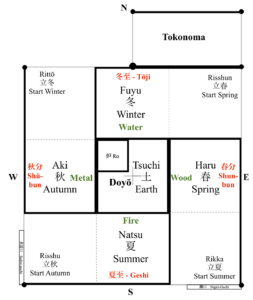
16 Do-yō, 土用, Earth-matter; start of the spring period of specific dos and don’ts. Han-getsu, 半月, half-moon. There are four Doyō in the calendar year, consisting of a period of 18 days, with one Doyō period at the end of each of the four seasons.18 times 4 is 72. Each season is a period of 73 days which in effect creates five seasons. Obviously, the numbers are slightly off, so that adjustments are made, such as adding a periodic ‘leap’ month, rather than ‘leap’ day. Considerations are made in reconciling the solar and lunar calendar years. Another influence on the calendar year is the references to the Go-gyō, 五行, Five-transitions, the five physical elements; Earth, Water, Fire, Metal, and Wood. East is Wood, South is Fire, West is Metal, North is Water, and the middle identified the four Doyō is Earth. This phenomenon is manifest in ideal yo-jō-han, 四畳半, four-tatami-half.
19 XV Iemoto, Urasenke, Hōunsai Daisōshō’s 101st Birthday. Also, Koku-u, 穀雨, Grain-rain; one of the 24 divisions of the solar calendar year. 1st day of Kyū-Ni-gatsu, 旧二月, Old calendar Two-month. Middle of old Tatsu, 辰年, Dragon, month.
21 Death of Sen no Rikyū; transposed lunar date of Kyū-reki, 旧暦, Old calendar, 2nd month 28th day of 1591, which was a year with a ‘leap’ second lunar month, like the ‘leap’ lunar 2nd month in 2023. The year 2024 is the 433rd anniversary of Rikyū’s death.
24 Man-getsu, 満月, Full-moon.
27 Dō-jō-ji, 道成寺, Way-attain-temple, E-shiki, 会式, Meeting-ceremony, Wa-ka–yama, 和歌山, Peace (Japan)-poetry-mountain. An enormous snake ‘puppet’ is carried overhead by a large number of people moving around the temple grounds. This is part of the legendary story of a woman shunned by a monk who transforms herself into a great snake, and causes his death under the temple’s burning bell. The tale is the source of several theatrical works identified by the name of the temple, Dōjōji.
28 Monthly memorial observance of the death of Sen no Rikyū.
29 Sho-wa no Hi, 昭和の日, Bright-harmony; former emperor’s birthday. National Holiday. In former times, the birthday of Hirohito, 裕仁, Abundant-humanity, (1901 – 1989) Emperor Shōwa. Mi-bu Kyō-gen, 壬生狂言, ‘Grand’ [Water’s older brother]-life Farce-words, comic, but sacred, plays performed at shrines and temples and on the Nō stage.
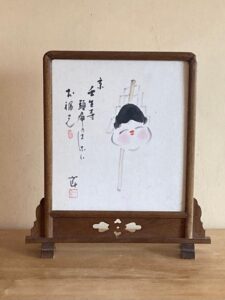
Shiki-shi, 色紙, color-paper, with painting of a mask of O-ta-fuku, お多福, Hon.-much-fortune, and a zigzag paper go-hei, 御幣, hon.-wand, with calligraphy, Kyō Mi-bu-dera zu-tsu no … fu-i O-fuku-san, 京 壬生寺 頭痛の … ふい お福さん, Capital Water-born-temple head-ache ’s …. lose; stamped and illegible signature. Displayed in a standing frame made of kuwa, 桑, mulberry, wood.
Mi-bu-dera, 壬生寺, Water-born-temple, has a long and complex history. The name of the temple in Kyōto comes from the swampy location where the temple was founded in the 8th century by a Chinese monk. Mibu is also the name of a gate of the old imperial palace. The Kanji, 壬, Mizu-no-e, Water’s -older brother, is the ninth of Ji-kkan, 十干, Ten-stems, ten signs based on the aspects of In, 陰, Yin, negative, and Yō, 陽, Yang, positive, and the Go-gyō, 五行, Five-elements.

Cha 茶月Tsuki for March 2024
Ya-yoi, 弥生, Increase-life, is the old name for the third month of the lunar calendar, as well as for March.
March – Third Month
1 Lunar 1st month, 21st day. Kinoe Ne, 甲子, Wood older brother Rat. First sign of 60 cycle of E-to, 干支, Stem-branch; combined Jū-ni-shi, 十二支, Ten-two-branches, the twelve animals of the zodiac and the Ji-kkan, 十干, Ten-intercede, two types – In, 陰, Yin, negative, and Yō, 陽, Yang, positive, of each of Go-gyō, 五行, Five-transitions, the physical elements – Wood, Fire, Earth, Metal, Water.
3 Hina-matsuri, 雛祭, Chick-festival. Momo no Se-kku, 桃の節句, Peach’s Divide-passage, is originally a lunar calendar festival. The crescent mi-ka-zuki, 三日月, Three-day-moon, is a prominent emblem of spring. Kyū Hinamatsuri, lunar festival observed on April 11.
6 Kei-chitsu, 啓蟄, Awaken-insects. The Kanji kei, 啓, means enlightenment; one of the 24 seasonal divisions of the solar year, and the start of the U no Tsuki, 卯の月, Hare ’s Month.
10 Tsuitachi, 朔, is the word for the first day of both the solar and lunar months, and is another word for the new moon.
12 Ni-gatsu-dō, 二月堂, Two-month-hall, O-mizu-tori, 御水取, Hon.-water-carry, Tō-dai-ji, 東大寺, East-great-temple, Nara.
13 Kasuga Tai-sha-sai, 春日大社祭, Spring-day Great-shrine-festival, Nara.
17 Han-getsu, 半月, half-moon. Hi-gan-iri, 彼岸入り, That-shore-enter, start of the observances of the Buddha’s Ne-han, 涅槃, Black soil-tub, Nirvana. A lunar event.
20 Shun-bun no Hi, 春分の日, Spring-division’s Day, midpoint of U-no-tsuki, 卯の月, Hare’s-month. National Holiday. Ne-han no Naka-hi, 涅槃の中日, Black soil-tub’s Middle day.
23 Hi-gan Ake, 彼岸明け, That-shore, last day of the solar equinox.
24 Kyū-ne-han, 旧涅槃, Old-black soil-tub, Nirvana of the Buddha, in conjunction with the full moon in Japan, which is on March 25.
25 Man-getsu, 満月, Full-moon. The death of the Buddha occurred during the third full moon.
28 Traditional Rikyū-ki, 利休忌, Rikyū-memorial, observed at Urasenke, Kyōto.

Cha 茶月Tsuki for February 2024 A solar leap year.
Tatsu-doshi, 辰年, Dragon-year. Lunar New Year February 10, 2024. The Kanji, 辰, means to tremble.
February, Kisaragi, 如月, Like-month. Nyo, 如, tathata (Buddhist ultimate nature of all things).
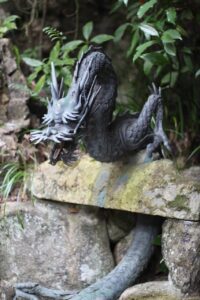
1 Lunar 12/22. Ei-hei-ji, 永平寺, Ever-peace-temple, start of intensive week of Buddhist abstinence called Ne-han-kai, 涅槃会, Black soil-tub-meeting, features the display of a painting of the death and Nirvana of the Buddha. Eiheiji is among the first temples to present an early form of Tea Ceremony brought from China.
3 Han-getsu, 半月, half-moon. Setsu-bun, 節分, Season-divide; eve of Shunbun, the start of Spring. “Oni wa fuku wa uchi”, 鬼は外福は内, Demon is out fortune is in. Daru-ma Ku-yō, 達磨供養, Attain-polish Offer-nurture, Daruma dolls that have brought good fortune for the year are burned with gratitude in temple sacred fires.
4 Ri-sshun, 立春, Start-spring; start Tora no Tsuki, 寅の月, Tiger’s Month. First day of a period of 88 days for tea-picking on May 2, which is called Hachi-jū-hachi-ya, 八十八夜, Eight-ten-eight-night. One of the 24 seasonal divisions of the solar year.
8 Koto-hajime,こと始め, Matters-begin, preparations for the New (lunar)Year.
10 Kyū-Shō-gatsu, 旧正月, Old-Correct-month, Tatsu-doshi, 辰年, Dragon-year. Kyū-gan-jitsu, 旧元日, Old-origin-day. Tatsu no Hi, 辰の日, Dragon’s Day. It is a remarkable coincidence that the lunar Dragon Year begins on a lunar Dragon Day in 2024.
11 National Holiday. Ken-koku-ki-nen no Hi, 建国記念の日, Build-country-account-sense’s Day, National Foundation Day; observances are held at Japan’s first imperial capital, Hashi-hara Jin-gū, 橿原神宮, Oak-field God-palace, Nara.
12 Holiday observance of Kenkoku Kinen no Hi. Hatsu Uma, 初午, First Horse, first day of the Horse after the Lunar New Year. Inari Ō-kami-sama, 稲荷大神様, Rice plant-carry Great-god-lord, god of rice cultivation, descended from on high on the first Horse Day of the 2nd month of the lunar calendar in the year 711. Fushi-mi Inari Tai-sha, 伏見稲荷大社, Downward-look Rice plant-carry Great-shrine, in Kyōto, is Japan’s main shrine dedicated to the god of rice.
14 Valentine’s Day, is lavishly observed in Japan, when women give chocolate candies to men.
15 Ne-han-kai, 涅槃会, Black soil-tub-meeting. Nehan is usually written with kana, ねはん, is Japanese for Nirvana, the death and ‘extinguishing’ of the Buddha. This is a lunar event that is also observed in the lunar calendar: 15th day of 2nd month, March 24, 2024.
16 Kyū Nana-kusa, 旧七草, Old Seven-plants. Haru no Nana-kusa, 春の七草, Spring’s Seven-plants; seven young spring herbs pounded and mixed with rice porridge, nana-kusa gayu, 七草粥, seven-plants gruel, eaten to dispel the heaviness of winter root vegetables, etc.
The seven herbs, in Japanese and the Latin vernacular, are:
seri, 芹, Japanese parsley, Oenanthe javanica.
nazuna, 薺, shepherd’s purse, Capsella bursa-pastoris.
go-gyō, 御形, hon.-shape, cottonweed, Gnaphalium affine.
hakobera, 繁縷, luxuriant-thread, chickweed, Stellaria sp.
hotoke no za, 仏の座, buddha’s seat, henbit, deadnettle, Lamium amplexicaule.
suzuna, 菘, turnip, Brassica rapa.
suzushiro, 蘿蔔, ivy-radish, Raphanus sativus var. longipinnatus.
17 Ni-no-Uma, 二の午, Two-’s-Horse. I-se Jin-gū Shin-nen-sai, 伊勢神宮新年祭, That-strength God-palace New-year-festival. Ise is the location of the ancient shrine dedicated to Ama-terasu Ō-kami, 天照大神, Heaven-brightener Great-god, the sun.
19 U-sui, 雨水, Rain-water: one of the 24 seasonal divisions of the solar calendar, Tora no Chū-ki, 虎の中気, Tiger’s mid-spirit.
20 New moon. Kyū-ni-gatsu, 旧二月, Old-two-month.
21 Tō-ji, 東寺, East-temple; monthly flea market.
23 Ten-nō Tan-jō-bi, 天皇誕生日, Heaven-emperor Born-life-day. National Holiday: to celebrate the birthday of Naru-hito, 徳仁, Virtue-benevolence, b. 1960.
24 Man-getsu, 満月, full-moon, also mochi, 望, full moon.
25 Kita-no Ten-man-gū, 北野天満宮, North-field Heaven-full-palace, Bai-ka-sai, 梅花祭, Prunus-flower-festival, lavish gathering at the shrine dedicated to Suga-wara Michi-zane, 菅原道真, Sedge-plain Way-truth, where many varieties of prunus are in bloom, and Chanoyu is presented by gei-sha, 芸者, art-ist, and mai-ko, 舞子, dance-child, and others.
28 Monthly observance of Rikyū Memorial.
29 Leap year day.
March 1 Lunar calendar Kyū-shō-gatsu, 旧正月, Old-true-month; Ne no Hi, 子の日, Rat’s Day.
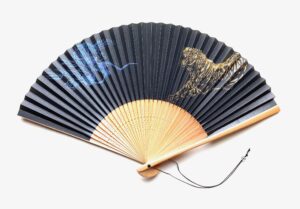
Sen-su, 扇子, fan-of, is a folding fan made of bamboo with black paper sen-men, 扇面, fan-face, with a print design of a sei-ryū, 青龍, blue dragon, and a kin-ko, 金虎, gold-tiger; with a beaded thread hanger. Such a fan, unlike those used in Chanoyu, may be used to fan oneself.
The pictured sensu has 33 hone, ribs, separate from the two end covers. The number 33 is symbolic of Infinity in Space. When one is subtracted from 33, the remainder is 32, and there are 32 petals on a version of the imperial, kiku-mon, 菊紋, chrysanthemum crest, radiating outward from the sun-like center. The imperial kikumon has 16 petals, and in variations, small petal tips are present between them, resulting in 32 petals. Kan-non Bo-satsu, 観音菩薩, See-sound Grass-buddha, has 33 different manifestations, indicating that Kannon is omnipresent.
In Asian beliefs, the dragon and tiger are often paired as a manifestation of In and Yō, 陰陽, Yin Yang, negative and positive.

Chatsuki for January 2024.
Rei-wa Roku, 令和六, Decree-harmony 6.
Ichi-gatsu, 一月, One-month. Shō-gatsu, 正月, Correct-month. Mutsu-ki, 睦月, Friendly-month, is the name of the first month of the lunar calendar year, and used for January.
1. Gan-jitsu, 元日, Origin-day. National Holiday. Lunar 11th month 20th day. Ne no Hi, 子の日, Rat’s Day. Hatsu Ne, 初子, First Rat (day of new year). Hatsu Mode, 初詣, First Shrine visit.
2. Hatsu Yume, 初夢, First Dream: Ichi Fu-ji, Ni Taka, San Nasu-bi: 一富士, 二鷹, 三茄子: One Noble-samurai, Two Hawk, Three Eggplants.
3. Hatsu Tora, 初寅, First Tiger.
4. Han-getsu, 半月, half-moon. Hatsu U, 初卯, First Hare.
5. Hatsu Sui-ten-gū, 初水天宮, First Water-heaven-palace; venerates Antoku of the Taira clan.
6. Shō-kan, 小寒, Little-cold, one of the 24 seasonal divisions of the year, start of the old Ushi-no-tsuki, 牛の月, Ox-’s-month. Hatsu Mi, 初巳, First Snake.
7. Nana-kusa, 七草, Seven-grasses, are seven kinds of herbs and plants mixed in a rice gruel. Jin-jitsu, 人日, Human-day, is the day when human beings were created. In Chanoyu, during ro presentation, i-mae, 居前, be-fore, uchi-zumi, 内隅, inner-corner of the ro is directed toward the northeast corner of the Tea room corresponding to the 7th day of the 1st lunar month.
8. Hatsu Yaku-shi, 初薬師, First Medicine-master. Sei-jin no Hi, 成人の日, Become-person’s Day, coming of age day, National Holiday.
9. Yoi Ebisu, 宵えびす, Eve Ebisu, god of seafarers.
10. Tō-ka E-bi-su, 十日恵比須, 10-day Bless-like-necessary. Ebisu is the first child of the primal gods, who became the god of fishermen. He is the only one of the Shichi-fuku-jin, 七福神, Seven-fortune-gods, that has his origin in Japan.
11. Lunar 1日 12 月, 1st day of lunar 12th month. Kagami biraki, 鏡開き, mirror-open, when there is the breaking of the mochi decorative offering, cooking, and eating it. The Buddhist guardian of the 11th day is Ko-kū-zō Bo-satsu, 虚空蔵菩薩, Empty-space-keep Grass-buddha, who also guards the Tearoom. Kagami mochi is offers at temples and shrines. The scared bronze mirror is a manifestation of Ama-terasu, 天照, Heaven-brightener. The mirror is also identified with Kan-non Bo-satsu, 観音菩薩, See-sound Grass-buddha.
12. Hatsu-I, 初亥, First-Boar.
14. Shi-ten-nō-ji, 四天王寺, Four-heaven-kings-temple, Ō-saka, 大阪, Great-slope; Doya-doya, sanctified ‘naked festival’. Doya–doya in English may be likened to the phrase ‘hiya hiya’. The temple was founded in 593 by Shō-toku Tai-shi, 聖徳太子, Holy-virtue Grand-child, who supported Buddhism in Japan.
15. Ko-shō-gatsu, 小正月, Little-true-moon. A-zuki gayu, 小豆粥, little-bean gruel, red beans and rice cooked together. One of the world’s great combination of nutritious rice and beans.
16. Sai-jitsu, 賽日, Worship-day; day to visit to pray at Shrines and Temples.
18. Do-yō, 土用, Earth-matter; start of the last 18 days to Ri-sshun, 立春, Start-spring, February 4. Each of the four seasons has its Doyō of 18 days, which totals 72 days. However, the 72 days of Doyō creates a fifth season; Spring, Summer, Autumn, Winter, and Earth. Hatsu Kan-non, 初観音, First See-sound; is venerated on the 18th day of each month. Kannon is the Buddhist Goddess of Mercy.
20. Dai-kan, 大寒, Great-cold; one of the 24 seasonal divisions of the solar year, and is the middle of the Ushi no Tsuki, 牛の月, Ox’s Month.
21. Hatsu Dai-shi, 初大師, First Great-master, is the first market of the year at Tō-ji, 東寺, East-temple, and veneration of Kō-bō Dai-shi, 弘法大師, Vast-law Great-master, Kyōto.
24. Hatsu Ji-zō, 初地蔵, First Earth-keep. Buddhist guardian of the world until the arrival of Mi-roku Bo-satsu, 弥勒菩薩, Increase-rein Grass-buddha.
25. Hatsu Ten-jin, 初天神, First Heaven-god, is the first market of the year at Kita-no Ten-man-gū, 北野天満宮, North-field Heaven-full-palace, Kyōto.
26. Mochi-zuki, 望月, Ambition-moon, full moon, also Man-getsu, 満月, Full-moon.
27. Waka-kusa-yama-yaki, 若草山焼, Young-grass-mountain-fire, Nara. The grass on the entire slope of the mountain is set on fire, preparing it for new growth.
28. Rikyū-ki, 利休忌, Rikyū-memorial; monthly observance of the death of Sen no Rikyū. Hatsu Fu-dō, 初不動, First No-move, fierce guardian and judge of Buddhism.
Kyū-Shō-gatsu, 旧正月, Old-Correct-moon; lunar New Year will be on February, 10 2024.

Chatsuki for December 2023
Jū-ni-gatsu, 十二月, Ten-two-month.
One of the old names for the lunar 12th month is Shi-wasu, 師走, Master-run, even professors rushing around preparing for the New Year.
Koyomi, 暦, Calendar, for the December 2023. Rei-wa, 令和, Order-harmony, 5th year.
Shi-wasu, 師走, Master-run; old name of the 12th lunar month. With all the preparations and holidays in December, it is such a busy time that even the teachers are running around.
1 Lunar 10th month 19th day.
3 Lunar E-bi-su-kō, 恵比寿講, Bless-like-longevity-association.
5 Han-getsu, 半月, half-moon. Osame no Sui-ten-gū, 納の水天宮, End’s Water-heaven-palace.
7 Tai-setsu, 大雪, Great-snow, one of the 24 seasonal divisions of the solar year, and start of the Ne no Tsuki, 子の月, Rat ’s Month.
8 Koto-osame, 事納め, Matters-end. Osame Yaku-shi, 納薬師, End Medicine-master. Jō-dō-e, 成道会, Attain-way-meet, the enlightenment of the Buddha.
Koto-hajime, 事始め, Matter-commence, start of New Year’s preparations. Kagami mochi, 鏡餅, mirror mochi, is brought by students to teachers, in thanks for efforts of the past year.
9 Daikoku’s birthday. Dai-koku, 大黒, Great-black, is a Hindu deity that is one of the Shichi-fuku-jin, and the god of rice.
10 Dai-tō-sai, 大湯祭, Great-hot water-festival, held annual at the Ō-miya Hira-kawa Jin-ja, 大宮氷川神社, Great-palace Ice-river God-shrine, in Saitama City. It is one of the oldest shrines in Japan, founded about 2,400 years ago. Urasenke presents Kencha, 献茶, Offering-tea on occasion, with other Tea gatherings.
13 New Moon, start of the lunar 11th month.
18 Osame Kan-non, 納め観音, Settlement See-sound, last day of the year venerating the Buddhist goddess of mercy.
20 Han-getsu, 半月, half-moon.
22 Ri-ttō, 立冬, Attain-winter; winter solstice, middle of the Ne no Tsuki, 子の月, Rat ’s Month. Yuzu-yu, 柚湯, citrus-hot water; yuzu, Citrus ichangensis x C. reticulata).
23 Tsuitachi, 朔, new moon; contraction of tsuki-tachi, 月立ち, moon-start.
25 Christmas.
27 Man-getsu, 満月, full-moon.
28 Monthly veneration of Sen no Rikyū. Osame no Fu-dō, 納めの不動, Settlement ’s No-move, last day of the year venerating the Buddhist deity who is the wrothful manifestation of Dai-nichi, 大日, Great-sun, who is the Buddhist universe made manifest.
31 New Year’s Eve. Jo-ya, 除夜, Exclude-night, New Year’s Eve. Jo-ya gama, 除夜釜, Exclude-night kettle, last Tea of the year. Joy-ya no kane, 除夜の鐘, Exclude-night’s bell; temple bells are rung 108 times to dispel desires to which all humans are subject.
January 1, 2024. Year of the Dragon. Ki-no-e Tatsu, 甲辰, Wood’s older-brother Dragon.
For further study, see also: December Observances, Tea in December, and more to come on December 15.

Chatsuki November 2023
Jū-ichi-gatsu, 十一月, Ten-one-month. Shimo-tsuki, 霜月, Frost-month.
1 Lunar 18th day of 9th month. I-no-ko Matsuri, 亥子祭, Boar-rat Festival, Go-ō Jin-ja, 護王神社, Protect-king God-shrine, Kyōto. The Boar is the shrine’s guardian. Daisōshō, Sen Hōunsai was born in the I-doshi, 亥年, Boar-year, 1923, and is closely acquainted with this shrine.
3 Bun-ka no Hi, 文化の日, Literary-change’s Day, Culture Day. National Holiday.
5 Han-getsu, 半月, Half-moon; waning quarter. ‘Waning’ Old English ‘wanian’, to decrease; ‘wax’, Old English ‘weaxen’, to grow.
8 Ri-ttō, 立冬, Start-winter; start of the lunar I no Tsuki, 亥の月, Boar’s Month: protected by A-mi-da, 阿弥陀, Praise-increase-steep, Buddha of Compassion.
11 Ichi no Tori, 一の酉, One’s Chicken, first day of the Chicken after Rittō, Start winter. Day at temples and shrines for marketing elaborate talismans for the winter, and prosperity in business.
13 Tsuitachi, 朔, first day of the lunar 10th month. Ro-biraki, 炉開, Hearth-open. I no Hi, 亥の日, Boar’s Day. I-no-ko mochi, 亥の子餅, Boar’s-child mochi. More fire and light is observed in the ro, as the nights get darker and longer. This may also be the reason for Dewali, the Festival of Lights observed in India beginning with the new moon.
15 Shichi-go-san, 七五三, Seven-five-three; honoring children of ages 7, 5, 3 at Shintō shrines.
19 Sō-tan-ki, 宗旦忌, Sect-dawn-memorial. Sen Sōtan, 1578~1658: the date of his death was Man-ji, 万治, Ten thousand-peace, 19th day of the lunar 12th month.
20 Han-getsu, 半月, Half-moon; waxing quarter.
22 Shō-setsu, 小雪, Small-snow; mid-point of lunar I no Tsuki, 亥の月, Boar’s Month. Tō-kan-ya, 十日夜, Ten-day-evening; lunar 10th day of 10th month, harvest festival. The gods of the rice field return to the mountains. People offer mochi dango, rice sheaves, eulalia grasses, and daikon to the moon.
23 Kin-rō Kan-sha-hi, 勤労感謝の日, Work-labor Emotion-thank ’s day; Labor Thanksgiving Day. National Holiday. America’s Thanksgiving Day. Ni no Tori, 二の酉, Two’s Chicken.
27 Man-getsu, 満月, Full-moon.
28 Monthly Rikyū Memorial.

Chatsuski October 2023
Jū-gatsu, 十月, 10-month. Kami-na-zuki, 神無月, God-no-month. The month in which all of the God-no-month; Shintō gods assemble at Izumo Tai-sha, 出雲大社, Out-cloud Great-shrine: Buddhist deities remain in their shrines.
The Tea presentation ‘Naka-oki’, 中置き, Middle-place, is offered: the portable fu-ro, 風炉, wind-hearth, is placed in the center of the dō-gu, 道具, way-tool, tatami.
Kyū Hachi-gatsu, 旧八月, Old Eight-month.
1 17th Day of the lunar 8th Month.
5 Daru-ma-ki, 達磨忌, Attain-polish-memorial, observances are held on the date of the death of Bodhidharma. The cause of his death is obscure, but it was thought that he was poisoned by jealous opponents. Daruma founded Zen Buddhism in China, and meditated for nine years facing a wall. He lost the use of his legs, but continued to sit upright no matter the situation.
6 Han-getsu, 半月, Half-moon.
8 Kan-ro, 寒露, Cold-dew; one of the 24 divisions of the solar year; start of the old month of the Inu, 戌, Dog. I-no-ko mochi, 亥の子餅, Boar-’s-child mochi. On the first day of the I, 亥, Wild-boar, in the 10th month, special sweets are prepared and enjoyed. These sweets are usually served at ro-biraki, 炉開, hearth-opening. In 2023, the ro is opened on November 13th.
9 Sports Day – National Holiday.
15 Tsuitachi, 朔, first day of the lunar 9th month.
20 E-bi-su-kō, 恵比寿講, Favor-like-longevity group; festivities honoring Ebisu, the Shintō god of fisherman and good fortune in business.
21 Do-yō, 土用, Earth-matters; start of 18-day period where certain activities are either encouraged or discouraged. Monthly produce and flea market at Tō-ji, 東寺, East-temple, Kyōto.
22 Han-getsu, 半月, half-moon. Ji-dai Matsuri, 時代祭, Time-generation Festival, comprised of a parade of people in historical Japanese apparel, with decorated floats that begins at Hei-an Jin-gu, 平安神宮, Level-peace God-palace, which is a replica of the ancient imperial palace, Kyōto. It started in 1895 to commemorate the 1100th anniversary of the transfer of the capital to Kyōto in 794.
23 Lunar Chō-Yō, 重陽, Multi-Yang; a confluence of lunar 9th month 9th day. Elaborate chrysanthemum plants are displayed at the Imperial Palace, and elsewhere. ChōYō is one of the traditional Five Festivals. The number 9 is the largest single numeral, is rich in symbolism, and manifests the aspect of Yō, 陽, positive, penetrative. The number 9 in geomancy is one surrounded by eight, radiating in all directions. Eight, hachi, 八, is a symbol of Infinity in Space, and can be visualized by the Kanji for rice, kome, 米. This image is the basis of many mandalas.
24 Sō-kō, 霜降, Frost-descend; one of the 24 divisions of the solar year; middle of the old month of the Inu, 戌, Dog.
25 Kita-no Ten-man-gū, 北野天満宮, North-field Heaven-full-palace, monthly flea and produce market.
28 Monthly memorial for Sen no Rikyū.
29 Man-getsu, 満月, full-moon.
30 Ten-ryū-ji Ken-cha-shiki, 天龍寺献茶式, Heaven-dragon-temple Offer-tea-ceremony, presented by Ura-sen-ke, 裏千家, Inner-thousand-family.
31 Halloween.

Chatsuki September 2023
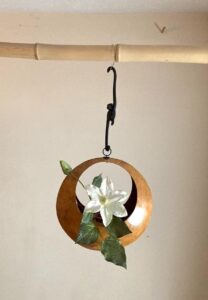
Ku-gatsu, 九月, Nine-month. Naga-tsuki, 長月, Long-moon, One of the old names for the ninth lunar month. The Kanji for nine, ku, 九, is also read kyū and kokono. The word kyū is a homonym for the Kanji kyū, also read nagai, 長, long, which is the origin of the old name for the ninth lunar month, Naga-tsuki, 長月, Long-moon. The full moon in September is often mistaken for ‘August Moon’.
‘The Teahouse of the August Moon’ is a novel by Vern Sneider published in 1951, relating the post-WWII activities of the US Army in Okinawa. It was adapted as a stage play, then as a film (Marlon Brando played a Japanese person), and, in 1970, it became a Broadway musical, ‘Lovely Ladies, Kind Gentlemen’. The title was mistaken for the Eighth lunar month, which occurs in September.
1 Is the 210th day of the year. Lunar 7th month 17th day
4 Kita-no Ten-man-gū Matsuri, 北野天満宮祭, North-field Heaven-full-palace Festival. Called the Kitano Festival, it is an annual event for prayers given for the prosperity of the imperial family, national security, bountiful harvests, and good health.
7 Han-getsu, 半月, half-moon.
8 Haku-ro, 白露, White-dew; one of the 28 divisions of the solar year, and start of the Tori no Tsuki, 酉の月, Rooster ’s Month.
9 Chō-yō, 重陽, Multiple-Yang; double number 9. The number 9 is the largest single number, and that it cannot be divided equally, and therefore in Asia it is an ‘ultimate’ Yang, 陽, or Japanese Yō. The yojōhan, 四畳半, four-mat-half, is theoretically, composed of nine squares, and is acknowledged as a magic square.
12 Lunar 28th day of month – Old calendar monthly Rikyū-ki, 利休忌, Rikyū-memorial.
15 New Moon. Tsuitachi, 朔, first day of the month. Kyū-ha-ssaku, 旧八朔, Old-eight-first day of month. Ro-jin no Hi, 老人の日, Old-person ’s Day. Iwa-shi-mizu Hachi-man-gū Matsuri, 石清水八幡宮, Rock-pure-water Eight-banner-palace Festival, Kyōto. Urasenke Tea Offering, and Tea Gatherings.
18 Kei-rō no Hi, 敬老の日, Respect-aged ‘s Day. National Holiday. The word kei, 敬, respect, is one of Rikyū’s Four Principles of Tea: Wa Kei Sei Jaku , 和敬静寂, Peace Respect Purity Tranquility.
20 Hi-gan-iri, 彼岸入り, Other-shore-enter, start of the seven-day period culminating in the autumnal equinox.
23 Han-getsu, 半月, half-moon. Hi-gan, 彼岸, Other-shore. Shū-bun no Hi, 秋分の日, Autumn-division’s Day, the autumnal equinox. National Holiday. One of the 24 seasonal divisions of the solar year, and mid-point of the Tori no Tsuki, 酉の月, Rooster’s Month.
26 Hi-gan ake, 彼岸明け, Other-shore end.
28 Monthly Rikyū-ki, 利休忌, Rikyū-memorial.
29 Jū-go-ya, 十五夜, Ten-five-night. Man-getsu, 満月, Full-moon. Mei-getsu, 名月, Name-moon.

Chatsuki August 2023
Hachi-gatsu, 八月, Eight-month. Old calendar lunar month called Ha-zuki, 葉月, Leaf-month.
1 Ha-ssaku, 八朔, Eight-first day; the first day of August is called hassaku, which is actually a lunar event. Traditionally, the first day of the 8th moon, which occurs on September 15, 2023. ‘Hassaku’ originated in the past when farmers on the first day of the eighth lunar month offered the first heads of rice to their lords. Now, it is a time for gift-giving. A popular treat at this time is bota-mochi, ボタ餅, ‘peony’-mochi; a sweet made of glutinous rice wrapped in sweetened red bean jam. These are also called o-hagi, お萩, hon.-bush clover.
Hachi-gatsu no saku-jitsu, 八月の朔日, 8 moon – first-day, shortened to hassaku and hatsu saku, is a day to honor Kō-bō Dai-shi, 弘法大師, Spread-law Great-master, and purification of the body and mind. August is at the height of the most Yō, 陽, positive time of the year.
2 Man-getsu, 満月, Full-moon (7th lunar month).
6 Sen-dai Tanabata Matsuri, 仙台七夕まつり, Hermit-support Seven Night Festival. The Sendai area of northern Hon-shū, 本州, Main-island, observes Tanabata on the 7th night of August, which is often closer to the lunar Tanabata. Anniversary of the 1945 bombing of Hiro-shima, 広島, Wide-island.
7 through 10, Go-jō-zaka Tō-ki Matsuri, 五条坂陶器祭り, Five-avenue-slope Ceramic-container Festival, Kyō-to, 京都, Capital-city.
8 Han-getsu, 半月, half-moon. Ri-sshu, 立秋, Start-autumn, one of the 24 seasonal divisions of the solar year.
9 Anniversary of the 1945 bombing of Naga-saki, 長崎, Long-cape.
11 Yama no Hi, 山の日, Mountain’s Day; a national holiday established in 2016, to revere the mountains of Japan.
12 A-wa–odori, 阿波おどり, Praise-wave-dance; annual festival held in Toku-shima, 徳島, Virtue-island, Shi-koku, 四国, Four-countries.
13 Tsuki-okure Bon Mukae-bi, 月遅れ盆迎え火, Month-later Tray Welcome-fire, fires lit in front of homes to welcome back departed spirits.
15 Tsuki-okure Bon, 月遅れ盆, Month-later Tray; Obon observed one month after the July Bon. The traditional lunar Obon is on August 30, 2023.
16 New Moon. Tsuitachi, 朔, First day of lunar 7th month. Tsuki-okure Okuri-bi, 送り火, Month-later Farewell-fire. Go-zan Okuri-bi, 五山送り火, Five-mountain Farewell-fires, Kyōto. Arashi-yama Tō-rō Nagashi, 嵐山灯籠流し, Storm-mountain Lamp-basket Flow; papered lanterns, mizu-tō-ba, 水塔婆, water-pagoda-nurse, (stupa), are set adrift on the Katsura-gawa, 桂川, Katsura-river, carry spirits back to paradise.
22 Kyū Tanabata, 旧七夕, Old Seventh-night, seventh night of the seventh lunar month, preparing for the O-bon, お盆, Hon.-tray, when spirits of the dead return to their homes. Han-getsu, 半月, half-moon. Stalks of bamboo decorated with tanzaku and ornaments dedicated to the Altair and Vega, which are part of the Summer Cross.
23 Sho-sho, 処暑, Manage-heat; the hot weather extremes begin to abate. One of the 24 seasonal divisions of the solar year, and the middle of Saru no Tsuki, の月, Monkey’s Month.
24 Han-getsu, 半月, Half-moon. Ji-zō Bon, 地蔵盆, Earth-keep Tray; Buddhist rites especially held for children in remembrance of departed spirits, with Jizō as a special guardian. Jizō helps the souls of children cross the San-zu no Kawa, 三途の川, Three-crossing’s River, in the underworld.
28 Monthly memorial observance for Sen no Rikyū.
30 Kyū Bon, 旧盆, Old Tray; the traditional date for observing Obon, in accord with the full moon of the lunar 7th month. The central deity of Obon and the full moon is A-mi-da Nyo-rai, 阿弥陀如来, Praise-increase-steep Like-become, the Buddha of Compassion. The Buddhist deity who’s En-nichi, 縁日, Fete-day, is the seventh day, is Sen-ju Kan-non Bo-satsu, 千手観音菩薩, Thousand-hand See-sound Grass-buddha.
31 Man-getsu, 満月, Full-moon. A Blue Moon and a Supermoon.
For further study, see also: Tea in August, Tea in July, August Tea Presentation, Obon at Night, August Seasonal Aspects

Chatsuki July, 2023.
Shichi-gatsu, 七月, Seven-month. Old lunar calendar Fumi-zuki, 文月, Letter-month.
1 Lunar Go-gatsu, 五月, Five-month, 14th day. Opening day for climbing Fu-ji-san, 富士山, Wealth-samurai-mountain. Wordplay on fuji includes 不二no-two, peerless. Fuji is an Ainu word for ‘fire’.
2 Han-ge-shō, 半夏生, Half-summer-live.
3 Man-getsu, 満月, Full-moon.
4 Sei-chū En-nō Mu-gen-ki, 精中圓能無限忌, Spirit-mid Circle-skill No-limit-memorial, Ura-sen-ke, 裏千家, Inner-thousand-family, Kyōto. Memorials honoring Sei-chū, 精中 / Gen-gen-sai, 玄々斎, Mystery-mystery-abstain, XI Oiemoto; En-nō, 圓能 / En-nō-sai, 円能斎, Circle-skill-abstain; XIII Oiemoto; Mu-gen, 無限 / Tan-tan-sai, 淡々斎, Light-light-abstain, XIV Oiemoto.
7 Tanabata, 七夕, Seven-night. Star Festival. Shō-sho, 小暑, Little-heat; one of the 24 seasonal divisions of the solar year, and start of the lunar sixth month, and the start of Mi-tsuki, 未月, Ram-month. The Kanji 未 means ‘not yet’.
9 Hō-zuki Ichi, 鬼灯市, Demon-lamp Market; at Asa-kusa Kan-non, 浅草観音, Shallow-grass See-sound, in Tōkyō, sale of plants for O-bon, お盆, Hon.-tray.
10 Han-getsu, 半月, half-moon.
13 Bon Mukaebi, 盆迎え火, Tray Welcome-fire; spirits return.
15 Bon, 盆, Tray, when spirits return to their ancestral homes. Offerings are presented on trays. Obon is a lunar event held in conjunction with the full seventh moon, with observances held from the 13 to the 16. In 2023, during lunar Obon on August 30, called Chū-gen, 中元, middle-origin, gifts are exchanged. Chūgen refers to the start of the second half of the lunar year.
16 Bon okuri-bi, 送り火, Tray farewell-fire, when spirits return to their eternal home.
18 Tsuitachi, 朔, New moon. First day of the lunar 6th month, bears the old name Mi-na-zuki, 水無月, Water-no-month.
22 Lunar 6th month 6th day; the wise Buddhist monk, Ho-tei, 布袋, Cloth-bag, was deemed reincarnation of Maitreya, Mi-roku Bo-satsu, 弥勒菩薩, Increase-rein Grass-buddha.
23 Tai-sho, 大暑, Great-heat, one of the 24 seasonal divisions of the solar year. Mid-point of lunar Hitsuji no Tsuki, 羊の月, Ram-month.
24 Ji-zō Bon, 地蔵盆, Earth-treasure Tray, Buddhist observances honoring Ji-zō Bo-satsu, 地蔵菩薩, Grass-buddha; Buddhist guardian of the world until the arrival of the supreme Buddhist savior, Maitreya, Mi-roku Bo-satsu, 弥勒菩薩, Increase-rein Grass-buddha.
26 Han-getsu, 半月, half-moon.
28 Monthly Ri-kyū-ki, 利休忌, memorial for Sen no Rikyū.
30 Do-yō no Ushi, 土用の牛, Earth-work ’s Ox, start of 18-day period at the end of the lunar Ox month, when certain works are avoided or encouraged.
31 Sen-nichi mairi, 千日詣, Thousand-day temple visit, Atago-yama, 愛宕山, Love-cave-mountain, northwest of Kyōto.

Chatsuki June 2023
Roku-gatsu, 六月, Six-month. Mi-na-zuki, 水無月, Water-not-month. Old name for the sixth lunar month. Minazuki, a lunar event, which in 2023 begins on July 18.
1 Lunar 4th month 13th day.
4 Man-getsu, 満月, full-moon.
6 Bō-shu, 芒種, Grain beard seed; one of the 24 divisions of the solar year. Start of lunar Uma no tsuki, 午の月, Horse’s month.
11 Nyū-bai, 入梅, Enter-Japanese apricot; start of the rainy season (in Kyōto), called tsu-yu, 梅雨, apricot-rain. Han-getsu, 半月, half-moon. The green fruit of the Prunus mume is put into alcohol and cube sugar, and aged to create ume-shu, 梅酒, apricot-alcohol. The fruit has been used in Asian medicine for more two thousand years to treat throat ailments and other bodily functions. Ume boshi, 梅干, prunus (salt-) dried, are prepared as well.
14 Sumi-yoshi Jin-ja, 住吉神社, Live-luck God-shrine, annual rice planting rites; ta-ue, 田植, ricefield-plant.
18 Chichi no hi, 父の日, Father’s Day. New moon – lunar Go-gatsu, 五月, Five-month, Sa-tsuki, 皐月, Swamp-month, rice planting month. The first Father’s Day was celebrated on June 19, 1910, in Spokane, Washington. Later, the third Sunday in June became the standard day of celebration. It is now observed around the world in many countries.
21 Ge-shi, 夏至, Summer-attain; mid-summer in Japan, starts summer in the west. One of the 24 solar calendar observances of the year, and the middle of the lunar Uma no tsuki, 午の月, Horse’s month.
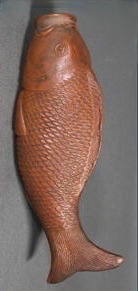
22 Lunar 5/5 Tan-go no Se-kku, 端午の節句, Start-horse’s Divide-passage. Old calendar Boy’s Day. Windsocks in the shape of fish, koi–nobori, 鯉幟, carp-banner, are flown. Carp ascending a waterfall is emblematic of Buddhist enlightenment.
26 Han-getsu, 半月, half-moon.
28 Monthly Ri-kyū-ki, 利休忌, Rich-quit-mourning; memorial for Sen no Rikyū.
30 Ō-harai, 大祓, Great-purification; major cleaning for the start of the second half of the year.

Chatsuki May 2023
The year 2023 – U-doshi, 卯年, Hare-year.
May – Calendar for Chanoyu. Go-gatsu, 五月, Five-month. Sa-tsuki, 皐月, Swamp (Shore)-month. The end of April and the beginning of May is the celebration of Golden Week. Showa no Hi, April 29, was Emperor Hirohito’s birthday. May 3, Constitution Day, Ken-pō-ki-nen-bi, 憲法記念日, Constitution-law-record account-attention-day. Midori no hi, Green Day, on May 4. May 5, Kodomo no Hi, Children’s Day, also called Tango no Sekku, festival for boys.
1 Lunar 3rd month 12th day.
2 Hachi-jū-hachi-ya, 八十八夜, Eight-ten-eight-night; tea picking.
3 Ken-pō-ki-nen-bi, 憲法記念日, Constitution-law-record-account-attention-day.
4 Midori no Hi, 緑の日, Greenery Day
5 Tan-Go no Se-kku, 端午の節句, Begin-Horse Divide-passage. Lunar Tango no Sekku is June 22 (2023).Ko-domo no Hi, 子供の日, Children’s Day. Koi nobori, 鯉のぼり, carp ascend/pennant.
6 Man-getsu, 満月, Full-moon. Ri-kka, 立夏, Start-summer, one of the 24 seasonal divisions of the solar year, and middle of lunar Mi no Tsuki, 巳の月, Snake’s Month.
10 Sho-bu-ro, 初風炉, First-wind-hearth, first official furo Tea presentation of the season.
13 Chi-dan-go Matsuri, 千団子祭, Thousand-round-of Festival, Mi-i-dera, 三井寺, Three-well-temple, Ō-tsu, 大津, Great-port.
14 Haha no Hi, 母の日, Mother’s Day.
15 Aoi Matsuri, 葵祭, Wild ginger Festival.
20 Han-getsu, 半月, half-moon.
21 Shō-man, 小満, Little-full; grain shows some fullness, one of the 24 seasonal divisions of the solar year,and middle of lunar Mi no Tsuki, 巳の月, Snake’s Month.
27 Lunar Kan-butsu-e, 灌仏会, Libate-Buddha-meeting, lunar 4th month 8th day.
28 Rikyū-ki, 利休忌, monthly remembrance of Sen no Rikyū. Zen-kō-ji, 善光寺, Good-light-temple, Mi-gawari Fu-dō Myō-ō Matsuri, 身代不動明王祭, Body-substitute No-move Bright-king Festival. The Ennichi of Fudō Myō-ō is the 28th day of each month.
Go-gatsu, 五月, Five-month, bears the old lunar name of Sa-tsuki, 皐月, Swamp-month. This is the time of ta-ue, 田植え, ricefield-plant, transplanting rice into flooded fields, 皐, swamp. The flower called sa-tsuki, 皐月, swamp-month, is the name of a type of azalea (Rhododendron indicum), which blooms at this time. The Chinese meaning of the Kanji, 皐, is high land along a river. A variant form of 皐 is 皋, which is composed of white, 白, great, 大, and ten, 十. It is thought that the compound refers to growing rice.

Chatsuki April 2023
The first week of April is when the cherry trees blossom in Kyōto. It is also the start of the school year.
1 Urū-Ni-gatsu, 二月, ‘Leap’-Two-month, 11 th day.
5 Sei-mei, 晴明, Pure-bright, one of 24 divisions of the solar year. Start of old Tatsu, 辰, Dragon month.
6 Man-getsu, 満月, Full-moon.
8 Kan-butsu-e, 灌仏会, Libate-buddha-meeting; anointing images of the newborn Buddha. Hana Matsuri, 花祭, Flower Festival; the Buddhist lotus is the flower that is revered.
10 Sakura Matsuri, 桜祭, Cherry Festival, Hira-no Jin-ja, 平野神社, Wide-field God-shrine, Kyōto.
13 Han-getsu, 半月, Half-moon. Jū-san Mairi, 十三詣り, Ten-three (shrine)Visit, Sa-ga Ko-kū-zō, 嵯峨虚空蔵, Crag-peak Empty-space-keep, Hō-rin-ji, 法輪寺, Law-ring-temple, Arashi-yama, 嵐山, Storm-mountain. Special rites for girls becoming women at age 13.
17 Do-yō, 土用, Earth-matter; start of the spring period of specific dos and don’ts.
20 Koku-u, 穀雨, Grain-rain; one of the 24 divisions of the solar calendar year. 1st day of Kyū-Ni-gatsu, 旧二月, Old calendar Two-month. Middle of old Tatsu, 辰年, Dragon, month.
21 Death of Sen no Rikyū; transposed lunar date of Kyū-reki, 旧暦, Old calendar, 2nd month 28th day of 1591, which was a year with a ‘leap’ second lunar month, like the ‘leap’ lunar 2nd month in 2023. The year 2023 is the 432 nd anniversary of Rikyū’s death.
22 Lunar Hina Matsuri, 雛祭, Doll Festival. Celebrating girls.
24 Matsu-o Dai-jin-ja, 松尾大神社, Pine-tail Great-god-shrine; annual festival at one of Kyōto’s oldest shrines.
27 Dō-jō-ji, 道成寺, Way-attain-temple, E-shiki, 会式, Meeting-ceremony, Wa-ka-yama, 和歌山, Peace (Japan)-poetry-mountain.
28 Han-getsu, 半月, half-moon. Monthly memorial observance of the death of Sen no Rikyū.
29 Sho-wa no Hi, 昭和の日, Bright-harmony; former emperor’s birthday. National Holiday.

March 2023
Ya-yoi, 弥生, Increase-life, is the old name for the third month of the lunar calendar, as well as for March. The Kanji are also read iya-oi.
1 Lunar 2nd month, 10th day.
3 Hina-matsuri, 雛祭, Chick-festival. Momo no Se-kku, 桃の節句, Peach’s Divide-passage, was originally a lunar calendar festival. The crescent mi-ka-zuki, 三日月, Three-day-moon, is a prominent emblem of spring. Kyu Hinamatsuri (article coming in Mid-April).
6 Kei-chitsu, 啓蟄, Awaken-insects. The Kanji kei, 啓, means enlightenment; one of the 24 seasonal divisions of the solar year, and the start of the U no Tsuki, 卯の月, Hare ’s Month.
7 Man-getsu, 満月, full-moon.
8 Shio-tsuki Ya-e-ko, 塩月弥栄子, Salt-moon Increase-splendor-child, memorial (2015).
13 Kasuga Tai-sha Matsuri, 春日大社祭, Spring-sun Great-shrine Festival.
15 Han-getsu, 半月, half-moon.
18 Hi-gan-iri, 彼岸入り, Other-shore-enter, start of the observances of the Buddha’s Ne-han, 涅槃, Black soil-tub, Nirvana. Originally a lunar event.
21 Shun-bun no Hi, 春分の日, Spring-division’s Day, midpoint of U-no-tsuki, 卯の月, Hare’s-month. National Holiday. Ne-han no Naka-hi, 涅槃の中日, Black soil-tub’s Middle-day.
22 Tsuitachi, 朔, is the word for the first day of both the solar and lunar months, another word for the new moon. The year 2023 is a leap year, when a ‘leap’ month, uru-zuki, 閏月, intercalary-moon/month, is added between the lunar 2nd and 3rd month.
24 Hi-gan-ake, 彼岸明け, Other-shore-leave, end of the Buddha’s Nehan observances.
28 Monthly observances of Rikyū’s memorial. See Rikyū’s Memorial
29 Han-getsu, 半月, half-moon.
For more information on Tea and Japanese culture in March, see also: Tea in March, Tea in March Part 2, Unryū Gama, Unryū Gama – A Petal Puzzle, Unryū Gama Picture Gallery, and Rikyū’s Take Jizai video

February 2023, U-doshi, 卯年, Hare-year, of the old lunar year.
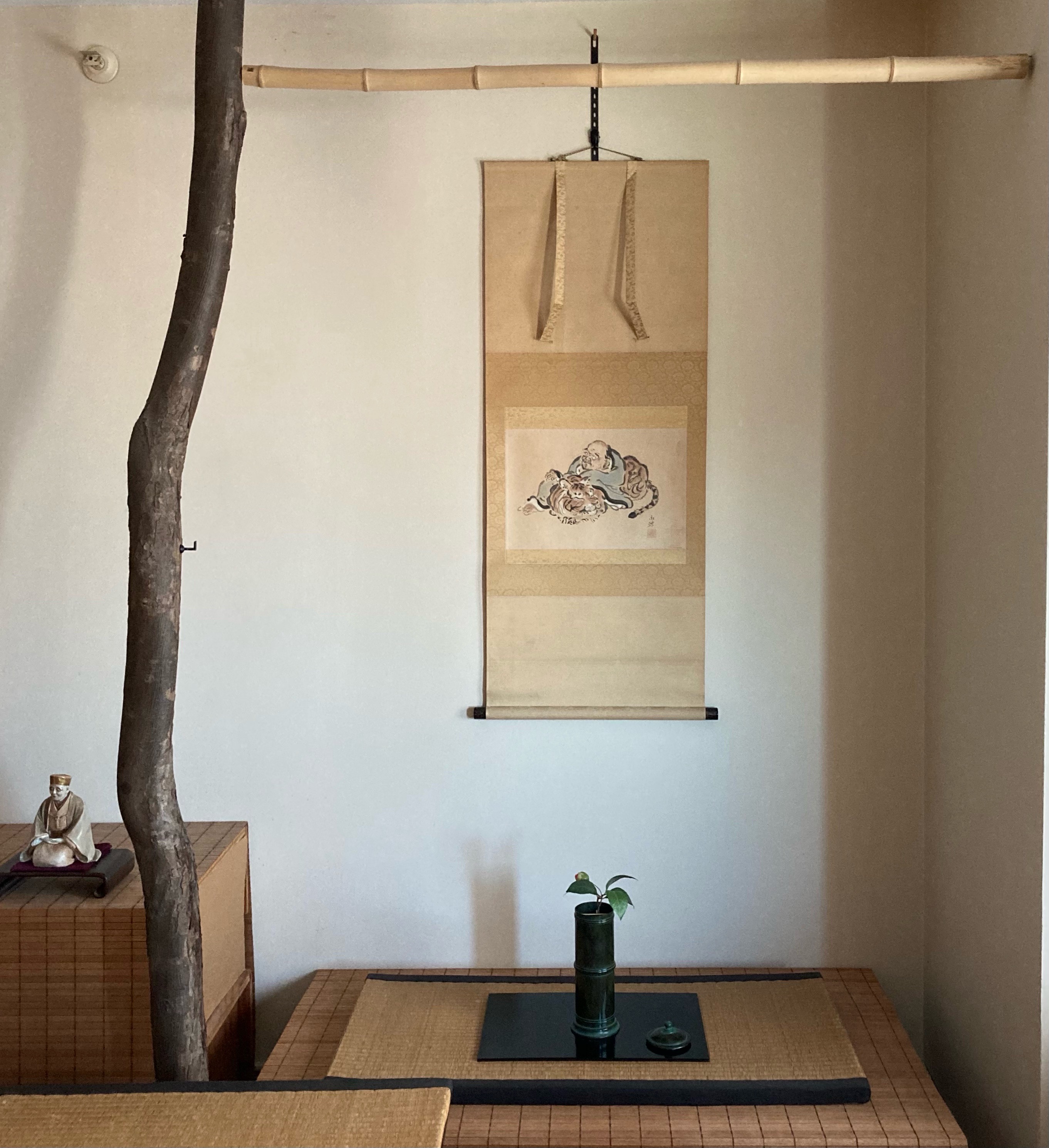
February 2023, U-doshi, 卯年, Hare-year, of the old lunar year.
1. Lunar 1 / 11. Ei-hei-ji, 永平寺, Ever-peace-temple, start of intensive week of Buddhist abstinence called Ne-han-kai, 涅槃会, Black soil-tub-meeting, display of a painting of the death and Nirvana of the Buddha.
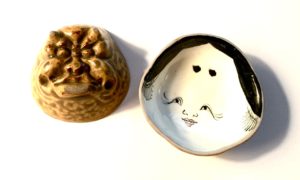
3. Sake cups with images of Otafuku and an Oni are enjoyed on Setsu-bun, 節分, Season-divide; festivities bidding farewell to the past year, with calls of “Oni wa fuku wa uchi”, 鬼は外福は内, Demon is out fortune is in. Daru-ma Ku-yō, 達磨供養, Attain-polish Offer-nurture, Daruma dolls that have brought good fortune for the year are burned with gratitude in temple sacred fires.
4. Ri-sshun, 立春, Start-spring; start Tora no Tsuki, 寅の月, Tiger’s Month. First day of a period of 88 days for tea-picking on May 2, which is called Hachi-jū-hachi-ya, 八十八夜, Eight-ten-eight-night. One of the 24 seasonal divisions of the solar year.
5. Hatsu-uma, 初午, First-horse, first Horse day of the year. Lunar Ko-shō-gatsu, 旧小正月, Old-little-correct-month, when mochi is eaten.
6. Man-getsu, 満月, Full-moon.
8. Koto-hajime, 事始め, Matters-begin, ordinary work begins after the lunar New Year festivities.
10. Kyū-ni-jū-nichi Shō-gatsu, 旧二十日正月, Old-two-ten-day Correct-month.
11. National Holiday. Ken-koku-ki-nen no Hi, 建国記念の日, Build-country-account-sense ’s Day, National Foundation Day; observances at Japan’s first imperial capital, Hashi-hara Jin-gū, 橿原神宮, Oak-field God-palace, Nara.
14. Han-getsu, 半月, half-moon.
15. Ne-han-kai, 涅槃会, Black soil-tub-meeting. Nehan is usually written with kana, ねはん, is Japanese for Nirvana, the death and ‘extinguishing’ of the Buddha. This is a lunar event that is also observed on the lunar calendar: 15th day of 2nd month, which corresponds with the vernal equinox: Shun-bun no Hi, 春分の日, Spring-divide ’s Day.

17. Ni-no-Uma, 二の午, Two-’s-Horse. I-se Jin-gū Shin-nen-sai, 伊勢神宮新年祭, That-strength God-palace New-year-festival. Ise is the location of the ancient shrine dedicated to Ama-terasu Ō-kami, 天照大神, Heaven-brightener Great-god, the sun.
19. U-sui, 雨水, Rain-water: one of the 24 seasonal divisions of the solar calendar, Tora no Chū-ki, 虎の中気, Tiger’s mid-spirit.
20. New moon. Kyū-ni-gatsu, 旧二月, Old-two-month.
23. National Holiday. Ten-nō Tan-jō-bi, 天皇誕生日, Heaven-emperor Born-life-day; Naru-hito, 徳仁, Virtue-benevolence, b. 1960. February 23. Go-dai-riki-son Nin-nō-e, 五大力尊仁王会, Five-great-strong-lord Benevolent-kings-meet, Dai-go-ji, 醍醐寺, Whey-gee-temple, Fushi-mi, 伏見, Bow-see, Kyōto. Go-dai-riki-san, 五大力さん, Five-great-strong-perso, is an event to pray for the peace of the country, and the happiness of the people by receiving the power of the Five Great Wisdom-kings, led by Fu-dō Myō-ō, 不動明王, No-move Bright-king. Its history can be traced back to 907, the era of Emperor Daigo.
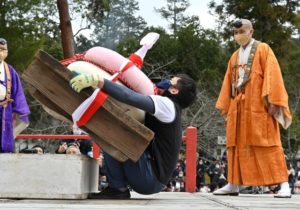
25. Kita-no Ten-man-gū, 北野天満宮, North-field Heaven-full-palace, Bai-ka-sai, 梅花祭, Prunus-flower-festival, lavish gathering at the shrine dedicated to Suga-wara Michi-zane, 菅原道真, Sedge-plain Way-truth, where many varieties of prunus are in bloom, and Chanoyu is presented by gei-sha, 芸者, art-ist, and mai-ko, 舞子, dance-child, and others.
27. Han-getsu, 半月, half-moon.
28. Monthly observance of Rikyū Memorial.
For more on Setsubun and Otafuku, see also: Setsubun and Otafuku (article), Setsubun and Otafuku (picture gallery), Setsubun Lecture (video), Setsubun Tea Gathering (video).

January 2023.
Rei-wa Itsutsu, 令和五, Decree-harmony 5.
Ichi-gatsu, 一月, One-month. Shō-gatsu, 正月, Correct-month. Mutsu-ki, 睦月, Friendly-month, name of the first month of the lunar calendar year, and used for January. The lunar New Year begins on January 22. Buddhist guardian of the lunar 1st month is Ko-kū-zō Bo-satsu, 虚空蔵菩薩, Empty-void-keep Grass-buddha.
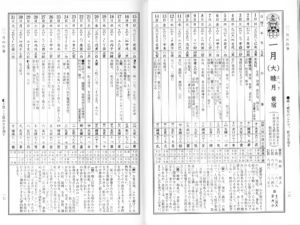
1. Gan–jitsu, 元日, Origin-day. National Holiday. Lunar 11th month 10th day.
2. National holiday observed. Hatsu Yume, 初夢, First Dream.
5. Hatsu I, 初亥, First Boar.
6. Shō-kan, 小寒, Little-cold, one of the 24 seasonal divisions of the year, start of old Ushi-no-tsuki, 牛の月, Ox-’s-month. Hatsu Ne, 初子, First Rat.
7. Mochi-zuki, 望月, Ambition-moon, full moon, also Man-getsu, 満月, Full-moon. Nana–kusa, 七草, Seven-grasses; seven kinds of herbs and plants mixed in a rice gruel. Jin-jitsu, 人日, Human-day; human beings were created on the seventh day. In Chanoyu, during ro presentation, i-mae, 居前, be-fore, uchi-zumi, 内隅, inner-corner of the ro is directed toward the northeast corner of the Tea room corresponding to the 7th day of the 1st lunar month.
8. Hatsu Tora, 初寅, First Tiger. Hatsu Yakushi, 初薬師, First Medicine-master.
9. Hatsu U, 初卯, First Hare. Sei-jin no Hi, 成人の日, Become-person’s Day, coming of age. National Holiday, which began in the Nara period, originally called Gen-puku, 元服, head-wear, when a child assumes adult responsibilities.
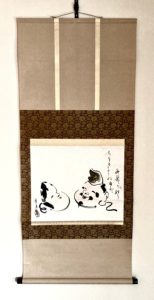
10. Tō-ka Ebisu, 十日恵比須, 10-day Bless-like-necessary. Good luck decorations are sold at shrines and temples across Japan, especially for fishermen and business. Ebisu is the first child of the primal gods, who became the god of fishermen. He is sole Japanese deity of the Shichi-fuku-jin, 七福神, Seven-fortune-gods.
11. Kagami biraki, 鏡開き, mirror-open, breaking the mochi decorative offering, cooking, and eating it. The Buddhist guardian of the 11th day is Ko-kū-zō Bo-satsu, 虚空蔵菩薩, Empty-space-keep Grass-buddha, he also guards the Tearoom. The mirror is sacred to Kannon, and it is used to protect against fire.
14. Shi-ten-nō-ji, 四天王寺, Four-heaven-kings-temple, Ō-saka, 大阪, Great-slope; Doya–doya, sanctified ‘naked festival’. The temple was founded in 593 by Prince Shotoku, who supported Buddhism in Japan.
15. Han-getsu, 半月, half-moon.
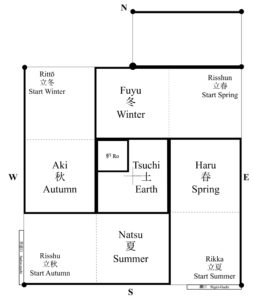
17. Do-yō, 土用, Earth-matter; start of the last 18 days to Ri-sshun, 立春, Start-spring, February 4. Each of the four seasons has its Doyō of 18 days, which totals 72 days. Through this system, the year is divided into five seasons; Spring, Summer, Autumn, Winter, and Earth.
18. Hatsu Kannon, , First See-sound; Kannon is the Buddhist Goddess of Mercy. Most Buddhist deities are male, however, some, like Kannon, are in female form.
20. Dai-kan, 大寒, Great-cold; one of the 24 seasonal divisions of the solar year, and the middle of the Ushi no Tsuki, 牛の月, Ox’s Month.
22. Kyū-Shō-gatsu, 旧正月, Old-Correct-moon; lunar New Year: Mizu-no-to U, 癸卯, Water’s-younger brother Hare.
24. Hatsu Ji-zō, 初地蔵, First Earth-keep. Buddhist guardian of the world until the arrival of Mi-roku Bo-satsu, 弥勒菩薩, Increase-rein Grass-buddha.
26. Birthday of Dō-gen Zen-shi, 道元禅師, Way-begin Zen-master, (1200 – 1253). In 1244, Dōgen founded Ei-hei-ji, 永平寺, Eternal-peace-temple; a Zen Sōtō–shū, 曹洞宗, Official-cave-sect. He also introduced a Song dynasty Tea rite that became part of the establishment of Chanoyu. (Dōgen will be profiled in a future article.)
28. Rikyū-ki, 利休忌, Rikyū-memorial; monthly observance of the death of Sen no Rikyū. Kyū Nana-kusa, 旧七草, Old Seven-grasses; seven kinds of young spring greens chopped, and cooked in a thin, rice gruel, kayu, 粥, congee. Nana-kusa gayu, 七草粥, seven-grasses gruel, the nourishing porridge helps to clear the system of the rich foods of the New Year festivities. The Kanji for kayu, 粥 composed of yumi, 弓, bow, kome, 米, rice, yumi, 弓, bow.
29. Han-getsu, 半月, Half-moon.

December 2022.
Shi-wasu, 師走, Master-run; old name of the 12th lunar month. With all the preparations and holidays in December, it is such a busy time that even the teachers are running around.
1. Lunar 11th month 8th day.
3. Ebisu’s birthday. E-bi-su, 恵比寿, Bless-like-longevity, the first born child of the primal couple Izanami and Izanagi, and the god of fishermen. He is the only Japanese god of the Shichi-fuku-jin, 七福神, Seven-fortune-gods. Often depicted with Dai-koku, 大黒, Great-black, the god of rice, and another of the Seven Fortune Gods.
5. Osame no Sui-ten-gū, 納の水天宮, Settlement ’s Water-heaven-palace, time to settle arrangements with the god. A yearly event that finalizes obligations. Of the many Suitengū throughout Japan, the main shrine is in Fukuoka, which was founded in 1185, and dedicated to Emperor Antoku. Prayers at the shrine are for ease in childbirth and safety on the sea.
7. Tai-setsu, 大雪, Great-snow, one of the 24 seasonal divisions of the solar year, and start of the Ne no Tsuki, 子の月, Rat ’s Month. The Buddhist protector of the zodiac sign of the Rat is Kan-non Bo-satsu, 観音菩薩, See-sound Grass-buddha, goddess of mercy.
8. Man-getsu, 満月, Full-moon. Jō-dō-e, 成道会, Attain-way-meet, the enlightenment of the Buddha. Last day of the eight days of strict Buddhist meditation called Rō-hatsu Se-sshin, 臘八接心, Offering-eight Contact-heart. The Kanji 臘is the offering ceremony according to the lunar calendar held on the third day of the Dog after the winter solstice, December 22. (See below.)
Koto-hajime, 事始め, Matter-commence, start of New Year’s preparations. Kagami mochi, 鏡餅, mirror-mochi, is brought by students to teachers, in thanks for efforts of the past year.
9. Daikoku’s birthday. Dai-koku, 大黒, Great-black, is a Hindu deity who in Japan became one of the Shichi-fuku-jin, and the god of rice. On this day some Japanese, especially in Niigata, celebrate O-toshi-ya, お歳夜, Hon.-year-eve, when Daikoku is offered a special dinner. There is a secret image of Daikoku at the Nichiren temple of Hon-pō-ji, 本法寺, Origin-law-temple, in Kyōto where part of Urasenke is located.
16. Han-getsu, 半月, half-moon.
18. Osame Kan-non, 納め観音, Settlement See-sound, last day of the year venerating the Buddhist goddess of mercy.
22. Ri-ttō, 立冬, Attain-winter; winter solstice, middle of the Ne no Tsuki, 子の月, Rat ’s Month. Regarding the Kanji ro, of Rō-hatsu Se-sshin, 臘八接心, Offering-eight Contact-heart, on December 8th, rō, 臘, offering, is composed of niku, 肉, flesh, and bristles, which may be a reference to the ancient Chinese ritual of ancestral offerings dried meat of the wild boar. The boar has stiff bristles, tategami, 巤, bristles. It is curious that the offering is held on a Dog day. According to the zodiac, the sign of the Dog is followed by the sign of the Wild Boar.
The successive sign is the Rat, Nezumi, 鼠, that has the Kanji that resembles aspects, 巤, of the Kanji for the rō, 臘. Part of the Asian diet has included rat meat for centuries. Perhaps the Rō offering, 臘, was rat meat, and may have an association with the sign of the Rat and Kannon who is the protector of the sign of the Rat. Rats are a symbol of prosperity, because they favor rice, and if one has rice, one is rich. The rat is a familiar to Dai-koku-ten, 大黒天, Great-black-heaven (deva), the god of rice and wealth. The rat has a close relationship with the elephant head Indian Hindu god, Ganesha, Kan-gi-ten, 歓喜天, Delight-joy-heaven (deva).
The Buddha learned from all that he saw and experienced, and the animals taught him many things about human behavior. The rat taught Buddha all about the aggression of the anxious mind, the madness, the curiosity, and the possibility to deal with both thoughts and material goods. In India, Ganesha is worshipped by Hindus in a five-day celebration called Pancha Ganapati, Five-face Ganesha, held from the winter solstice to the 25th.
23. Tsuitachi, 朔, new moon; contraction of tsuki-tachi, 月立ち, moon-start.
25. Christmas.
28. Monthly veneration of Sen no Rikyū. Osame no Fu-dō, 納めの不動, Settlement ’s No-move, last day of the year venerating the Buddhist deity who is the wrothful manifestation of Dai-nichi, 大日, Great-sun, who is the Buddhist universe made manifest.
31. New Year’s Eve. Jo-ya, 除夜, Exclude-night, New Year’s Eve. Jo-ya gama, 除夜釜, Exclude-night kettle, last Tea of the year. Joy-ya no kane, 除夜の鐘, Exclude-night’s bell; temple bells are rung 108 times to dispel desires to which all humans are subject. The number 108 is symbolic of many things including 6, the number of Infinity in Time, times 18, is the number symbolic of ‘life’. It combines the numbers 10 and 8.
2023 Reiwa 5. Year of the Hare.
The next animal of the Asian zodiac following this year of the Tiger, in 2023, is the Rabbit: U-doshi, 卯年, Hare-year, begins on January 22. It is the year of the Mizunoe U, 壬卯, Water-s older brother Hare. The Kanji for the zodiac animal is u, 卯, wild hare, and the Kanji for the actual animal is usagi, 兎, hare, rabbit.

Toshi-toku-jin, 歳徳神, Year-virtue-god, Taoist and Shintō female deity who determines aspects of On-myō-dō, 陰陽道, Yin-Yang-way, Negative-Positive influences foretold by a Taoist deity, identifies good and bad directions, and predicts the fates of the coming New Year. Depicted enthroned, and holding the hō-ju, 宝珠, treasure-jewel. The E-hō, 恵方, Favor-direction, of 2023 is Mizunoe, 壬, Water’s elder brother, north-northwest.

November 2022.
Jū-ichi-gatsu, 十一月, Ten-one-month.
Jū-ichi-gatsu, 十一月, Ten-one-month. Shimo-tsuki, 霜月, Frost-month, alteration of word for food or rice offering. The shimo is thought to have derived from oshimono, 粮, food, provisions, etc., which is the rice offered during the Ni-name-sai, 新嘗祭, New-taste-festival, ceremonial offering to the deities by the Emperor of newly-harvested rice, held annually on November 23.
Buddhist guardian of November is Kan-non Bo-satsu, 観音菩薩, See-sound Grass-buddha, the goddess of mercy. The 11th month is marked with the Asian zodiac sign of the Ne, 子, Rat.
1. Han-getsu, 半月, half-moon. Lunar 10th month 8th day.
3. Bunka no Hi, 文化の日, Culture’s-day, national holiday.
4. Ichi no Tori, 一の酉, One ’s Rooster; first day of the Rooster in November when shrines and temples open markets selling elaborate talismans for success in business. Tori no Ichi, 酉の市, Rooster ’s Market. These markets are held at shrines such as the Ōtori Jin-ja, 鷲神社, Eagle God-shrine, in the area of Asa-kusa, 浅草, Shallow-grass, of Tōkyō.
6. I no Hi, 亥の日, Boar ’s Day. Theoretically, this should be the day for Robiraki, but it is not after Rittō, which is the following day in 2022.
7. Ri-ttō, 立冬, Start-winter, one of the 24 seasonal divisions of the solar year, and start of I no Tsuki, 亥の月,
Boar ’s Month.
8. Man-getsu, 満月, Full-moon.
13. Momi-ji Matsuri, 紅葉まつり, Red-leaves Festival, Arashi-yama, 嵐山, Storm-mountain, Kyōto. Lunar Ebisu–kō, えびす講, Ebisu-association, held throughout Japan. Ebisu is the first-born child of the primal deities, Izanagi and Izanami, and is the Shintō god of fishermen.
15. Shichi Go San Mōde, 七五三詣, Seven Five Three Pilgrimage; festival celebrating children of the ages seven five and three.
16. Ni no Tori, 二の酉, Two ’s Rooster; second day of the Rooster in the 11th month.
17. A-mi-da Nyo-rai, 阿弥陀如来, Praise-increase-steep Like-become, tan-jō-bi, 誕生日, born-live-day. It may for some difficult to believe that an immortal deity should have birthday. Amida’s En-nichi, 縁日, Edge-day, occurs monthly with the full moon.
19. Sō-tan-ki, 宗旦忌, Sect-dawn-memorial, Urasenke, Kyōto.
23. Kin-rō Kan-sha no Hi, 勤労感謝の日, Work-labor Thanks-giving’s Day; a national holiday.
24. Thanksgiving Day in the United States.
28. Monthly observance of Ri-kyū-ki, 利休忌, Rich-quit-memorial. San no Tori, 三の酉, Three ’s Rooster; third day of the Rooster in the 11th month,
The official Robiraki was held on October 25, 2022, which was not exactly according to traditional custom. This was due in part to the fact that the lunar and solar calendars are greatly out of sync.
Robiraki. October 25 was marked by the sign of I no Hi, 亥の日, Boar ’s Day, which would indicate the day for the opening of the ro. However, that did not happen, as the ro is opened on the first Boar Day of the Boar Month. This occurred after Ri-ttō, 立冬, Start-winter, which is one of the 24 seasonal divisions of the solar year and the start of I no Tsuki, 亥の月, Boar’s-month, November 7, 2022.

October, Jū-gatsu, 十月, Ten-month.
Kami-na-zuki, 神無月, God-no-month. The month in which all of the Shintō deities assemble at Izumo Tai-sha, 出雲大社, Out-cloud Great-shrine.
Kyū Ku-gatsu, 旧九月, Old Nine-month.
1 Lunar 6th Day of the 9th Month. I-no-ko mochi, 亥の子餅, Boar-’s-child mochi. On the first day of the I, 亥, Wild-boar, in the 10th month, special sweets are prepared and enjoyed. These sweets are usually served at ro-biraki, 炉開, hearth-opening. In 2022, the ro is opened on October 25th.
4 Lunar Chō-Yō, 重陽, Multi-Yang; confluence of lunar 9th month 9th day. Chrysanthemums on display. One of the traditional five festivals.
5 Daru-ma-ki, 達磨忌, Attain-polish-memorial, observances are held on the date of the death of Bodhidharma. The cause of his death is obscure, but it was thought that he was poisoned by jealous opponents.
8 Kan-ro, 寒露, Cold-dew; one of the 24 divisions of the solar year; start of the old month of the Inu, 戌, Dog.
Ken-cha, 献茶, Offer-tea, Yoshi-da Jin-ja, 吉田神社, Luck-field God-shrine, Kyōto.
10 Sports Day.
20 Doyō, 土用, Earth-matters; start of 18-day period where certain activities are either encouraged or discouraged.
20 E-bi-su-ko, 恵比須講, Bless-compare-necessary-association, annual event honoring Ebisu, with prayers for the safety of the year, for a good harvest, big catch, or prosperous business. The rites are also held on the 20th day of the lunar 10th month. Curiously, Ebisu, who is enshrined at Izumo, does not attend the gathering of the multitudes of Shintō deities in the 10th month.
22 Ji-dai Matsuri, 時代祭, Time-generation Festival; parade of people in historical Japanese apparel, with floats, Hei-an Jin-gu, 平安神宮, Level-peace God-palace. Replica of the ancient imperial palace, Kyōto. It started in 1895 to commemorate the 1100th anniversary of the transfer of the capital to Kyoto in 794. One of the three great festivals of Kyōto: Aoi Matsuri, 葵祭, Wild ginger Festival, May 15, Gi-on Matsuri, 祇園祭, God-garden Festival, July 17.
23 Sō-kō, 霜降, Frost-descend; one of the 24 divisions of the solar year; middle of the old month of the Inu, 戌, Dog.
28 Monthly memorial observance for Sen no Rikyū.
30 Ten-ryū-ji Ken-cha-shiki, 天龍寺献茶式, Heaven-dragon-temple Offer-tea-ceremony. Presented by Ura-sen-ke, 裏千家, Inner-thousand-family. One of the glorious autumnal events in the Tea Year.

August Calendar for Chanoyu.
August 4. Kyū Tana-bata, 旧七夕, Old Seven-night; a lunar event more popularly observed on July 7.
August 7 Ri-sshu, 立秋, Start-autumn; 24 seasonal divisions of the solar year. Start of the lunar seventh month, Saru no Tsuki, 申の月, Monkey’s Month.
August 10 Mukae–bi, 迎火, Welcome-fire. Small fires are built in front of the home to welcome departed spirits from paradise.
August 12 Kyū Bon, 旧盆, Old Tray, when spirits of the dead return to their homes during the full lunar seventh month.
August 13 Okuri-bi, 送り火, Farewell-fire. Fires that are similar to the mukae-bi, 迎火, welcome-fire, built in front of the home to welcome Obon.
August 23 Sho-sho, 処暑, Limit-heat; one of the twenty-four seasonal divisions of the solar year. The mid-point of the lunar month of the Monkey, Saru, 申.
August 24 Ji-zō Bon, 地蔵盆, Earth-keep Tray; Buddhist rites especially held for children in remembrance of departed spirits, with Jizō as a special guardian. Jizō helps the souls of children cross the San-zu no Kawa, 三途の川, Three-crossing’s River, in the underworld.
August 27 Start of lunar Hachi-gatsu, 八月, Eight-month.
August 28 Monthly memorial for Sen no Rikyū, Rikyū-ki, 利休忌.

July Calendar for Chanoyu.
2 Han-ge-shō, 半夏生, Half-summer-live.
7 Tana-bata, 七夕, Seven-night; a lunar event observed in August, but in most areas of Japan it is held in July. The moon of the seventh night is han-getsu, 半月, half-moon. Elaborate displays of bamboo poles decorated with tan-zaku, 短冊, short-volume, paper strips with prayers and poems dedicated to the stars of Altair and Vega. Tanabata is the traditional beginnings of preparations for O-bon, お盆, Hon.-tray, when departed spirits return home, and are honored on the full moon. Tanabata will be detailed in the August Chanoyu Decoded.
7 Shō-sho, 小暑, Little-heat; one of the 24 seasonal divisions of the solar year, and start of the lunar sixth month, and the start of Mi-tsuki, 未月, Ram-month. The Kanji 未 means ‘not yet’.

9 Hō-zuki Ichi, 鬼灯市, Demon-lamp Market; is a sale of Chinese lantern plants for Obon, at the temple of Asa-kusa Kan-non, 浅草観音, Shallow-grass See-sound, in Tōkyō. The hōzuki plant has many names, and in English is groundcherry. The hōzuki ‘lantern’ is named in part for the hō-ju, 宝珠, treasure-jewel, Cintamani stone, or wish-fulfilling jewel, because of its close resemblance to the covering and the fruit.
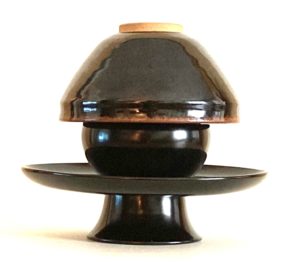
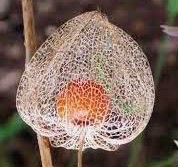
The cup of the Ten-moku dai, 天目台, Heaven-eye support, is called hōzuki, 鬼灯, demon-lamp. The Tenmoku teabowl resembles somewhat the conical husk of the hōzuki. The word hō-zu-ki could be written 宝珠器, treasure-jewel-container.
13 Bon begins and end on 15 with farewell fires. A lunar full moon event in 2022 occurs on August 12.
15 Chū-gen, 中元, middle-origin, the fifteenth day of the seventh lunar month, the final day of Bon festival. Gifts are often exchanged. Chūgen will be detailed in the August Chanoyu Decoded article.
17 Gi-on Matsuri, 祇園祭, God-garden Festival, Ya-saka Jin-ja, 八坂神社, Eight-hills God-shrine, Kyōto – one of the three great festivals of Japan. Parade of floats representing various districts of Kyōto. Begun in the 869 to avert a plague of diseases and the eruption of Fuji-san. The main deity of the shrine is Go-zu Ten-nō, 牛頭天王, Ox-head Heaven-king, named for the city of the Buddha’s birth. He is identified with Su-sa-no-ō, 素盞嗚命,Elemental-cup-weep-life, brother of Ama-terasu O-kami, 天照大神, Heaven-brightener Great-god. Yasaka Jinja has a long and very complex history, but remains one of the central shrines of Kyōto. Iemoto offers Tea at the shrine each summer.
20 Do-yo, 土用, Earth-utilize; period of eighteen days at the end of each of the four seasons, in which certain activities are avoided. In some thought, the traditional Japanese year has five seasons, Earth being one of them. This is manifest in the yo-jō-han, 四畳半, four-mat-half, where the half mat in the center is symbolic of Earth.
23 Tai-sho, 大暑, Great-heat; one of the 24 seasonal divisions, and the mid-point of the Ram Month.

Ji-zō Bon, , Earth-keep Tray. Kyōto children praying with a very long string of ju-zu, 数珠, numerous-jewels, as a Buddhist priest recites scripture dedicated to Jizō, the guardian of the world until the arrival of Maitreya, Mi-roku Bo-satsu, 弥勒菩薩, Increase-rein Sacred tree-buddha.
24 Ji-zō Bon, 地蔵盆, Earth-keep Tray; special Buddhist services especially for children.
28 Monthly Rikyūki. , remembrance of Sen no Rikyū, who died on the 28th day of the 2nd lunar month.
29 New 7th Moon; start of the second half of the lunar year.
The Asian zodiac animal sign for the lunar seventh month is the Saru, 申, Monkey. The Buddhist guardian of the seventh lunar month is Dai-nichi Nyo-rai, 大日如来, Great-sun Like-become, who is also the guardian of the sixth month. Collectively, the direction is the southwest, which is marked with the Eki-kyō, 易経, Change-sutra, trigram of Hitsuji-Saru and Kon, 坤, identified with Earth. In the ideal yo-jō-han, 四畳半, four-mat-half, the southwest corner is the location where the tei-shu, 亭主, house-master, sits when greeting the guests.

June Calendar for Chanoyu.
Roku-gatsu, 六月, Six-month. Mi-na-zuki, 水無月, Water-not-month. Old name for the sixth lunar month.
1 Lunar 5/3.
3 Lunar 5/5 Tan-go no Se-kku, 端午の節句, Start-horse’s Divide-passage. Old calendar Boy’s Day.
6 Bō-shu, 芒種, Grain beard-seed; one of the 24 divisions of the solar year. Start of lunar Uma no tsuki, 午の月, Horse’s month.
7 Han-getsu, 半月, half-moon.
11 Nyū-bai, 入梅, Enter-Japanese apricot; start of the rainy season (in Kyōto), called tsu-yu, 梅雨, apricot-rain.
14 Man-getsu, 満月, full-moon.
19 Chichi no hi, 父の日, Father’s Day.
21 Ge-shi, 夏至, Summer-attain; mid-summer in Japan, starts summer in the west.
28 Monthly Ri-kyū-ki, 利休忌, Rich-quit-mourning; memorial for Sen no Rikyū.
29 Lunar 6/1. The true Minazuki, when the rainy season stops.30 Ō-harai, 大祓, Great-purification; major cleaning for the start of the second half of the year.

Events in May
1 Lunar 4/1.
2 Hachi-jū-hachi-ya, 八十八夜, Eight-ten-eight-night; tea picking.
3 Ken-pō-ki-nen-bi, 憲法記念日, Constitution-law-record-account-attention-day.
4 Midori no Hi, 緑の日, Greenery Day
5 Tan-Go no Se-kku, 端午の節句, Begin-Horse Divide-passage. Lunar Tango no Sekku is June 3 (2022). Ri-kka, 立夏, Start-summer. Ko-domo no Hi, 子供の日, Children’s Day.
8 Haha no Hi, 母の日, Mother’s Day.
9 Han-getsu, 半月, half-moon.
10 Sho-bu-ro, 初風炉, First-wind-hearth, first official furo Tea presentation of the season.
15 Aoi Matsuri, 葵祭, Wild ginger Festival.
16 Man-getsu, 満月, Full-moon.
20 Shin-ran Tan-jō-bi, 親鸞, Parent-imperial, founder of Jō-do Shin-shū, 浄土真宗, Pure-land True-sect.
21 Shō–man, 小満, Little-full; grain shows some fullness.
23 Han-getsu, 半月, half-moon.
28 Rikyū-ki, 利休忌, monthly remembrance of Sen no Rikyū.
30 Lunar 5/1.

Events in April.
The first week of April is when the cherry trees blossom in Kyōto. It is also the start of the school year.
3 Old calendar Hina Matsuri, 雛祭, Chick Festival, girls’ day doll festival.
5 Sei-mei, 晴明, Pure-bright, one of 24 divisions of the solar calendar year.
8 Kan-butsu–e, 灌仏会, Libate-buddha-meeting; bathing images of the newborn Buddha.
Hana Matsuri, 花祭, Flower Festival; the Buddhist lotus is revered.
9 Han-getsu, 半月, half-moon.
10 Sai-dai-ji, 西大寺, West-great-temple, O-cha-mori, お茶盛, Great-tea-mound.
17 Do-yō, 土用, Earth-matter; start of the spring period of specific dos and don’ts. Full moon.
20 Koku-u, 穀雨, Grain-rain; one of the 24 divisions of the solar calendar year.
23 Han-getsu, 半月, half-moon.
24 Matsu-o Dai-jin-ja, 松尾大神社, Pine-tail Great-god-shrine; annual festival at one oldest shrines.
29 Sho-wa no Hi, 昭和の日, Bright-harmony; former emperor’s birthday.

Events in March.
Yayoi, 弥生, Increase-life; old name for the third moon, presently the name for March. The Japanese do not use the word March, but rather San-gatsu, 三月, Three-moon [month].
Kai-awase, 貝合, shell-fit; seashells are emblematic of the third month. Part of a bride’s trousseau was a set of one-hundred eighty hamaguri, 蛤, clam, shells, bivalves. Shells are familiar motifs for Hina Matsuri on the 3rd of the 3rd month. There is a game called kai-awase in which one tries to match the shells, and only those two halves fit together, which is symbolic of wedded happiness. There is a half-shelf for the ‘ideal’ lunar three-hundred and sixty days of the year, thirty-day months. The additional five day are identified with the concept of Earth as the center. In the yojōhan Tearoom, the center of the room is identified with the Earth, as one of the Go-gyō, 五行, five-transitions, the five earthly elements. The ro manifests these five elements: earth, water, fire, metal, and wood.
3– Hina Matsuri, 雛まつり, Chick Festival; display of dolls representing the old imperial court. Girls Day. More formally called Momo-no-se-kku, 桃の節句, Peach-’s-division-phrase, it is the season in which peaches bloom. Originally, a lunar calendar event. On this date, the number 3 is doubled 3rd day 3rd month, that in China from which it was borrowed is unlucky. The number 3 is a Yō, positive number as it cannot be equally divided in half.
15 – Ne-han-e, 涅槃会, Black-tub-meet: the death and nirvana of the Buddha, The fifteenth day of the third moon ideologically coincides with the vernal equinox, Shun-bun, 春分, Spring-division – the middle of the spring, and a ‘perfect’ time for the Buddha to pass from this life to the western paradise. It is also called Hi-gan, 彼岸, Other-shore, referring to crossing a great river to attain enlightenment and salvation. Higan is observed in April.
28 – Ri-kyū-ki, 利休忌, Rich-quit-memorial; Buddhist services in memory of the death of Rikyū. He died on the twenty-eighth day of the second moon in 1591. That year, in Japan, was a leap year, urū-doshi, 閏年, intercalary-year, according to the kyū-reki, 旧暦, old calendar, in which a full month is added to the calendar to make lunar events more closely correspond to the solar calendar. In 1591 a second month was added after the first lunar first month, so that the 28th day of the ‘second’ moon occurred on April 21st. Because of the great difference between the lunar and solar calendar, Urasenke observes Rikyūki on the 28th day of March.
Yayoi-jin, 弥生尽, extensive-life-last day; jin, 尽, last day of a month, usually the lunar calendar.

